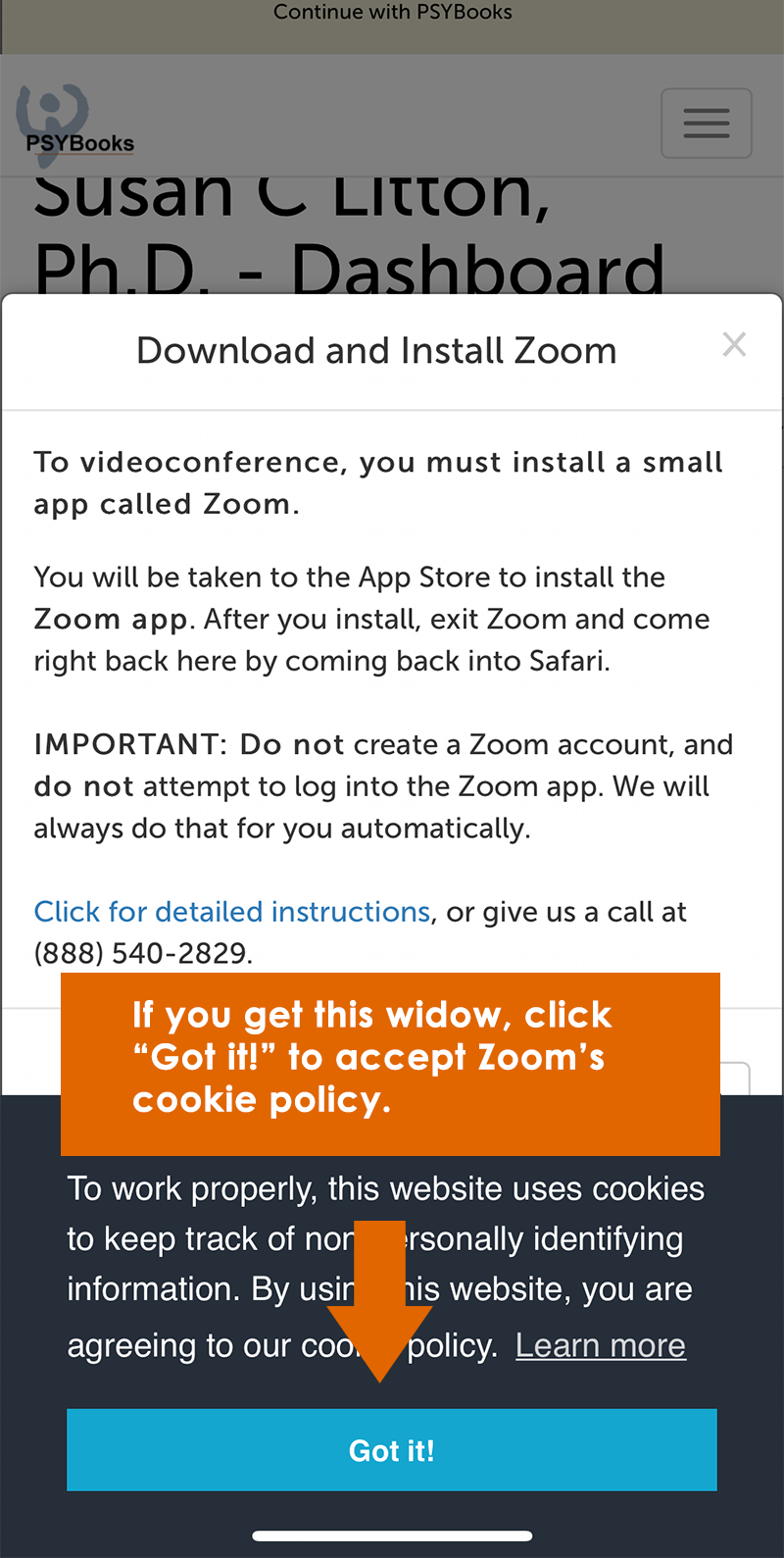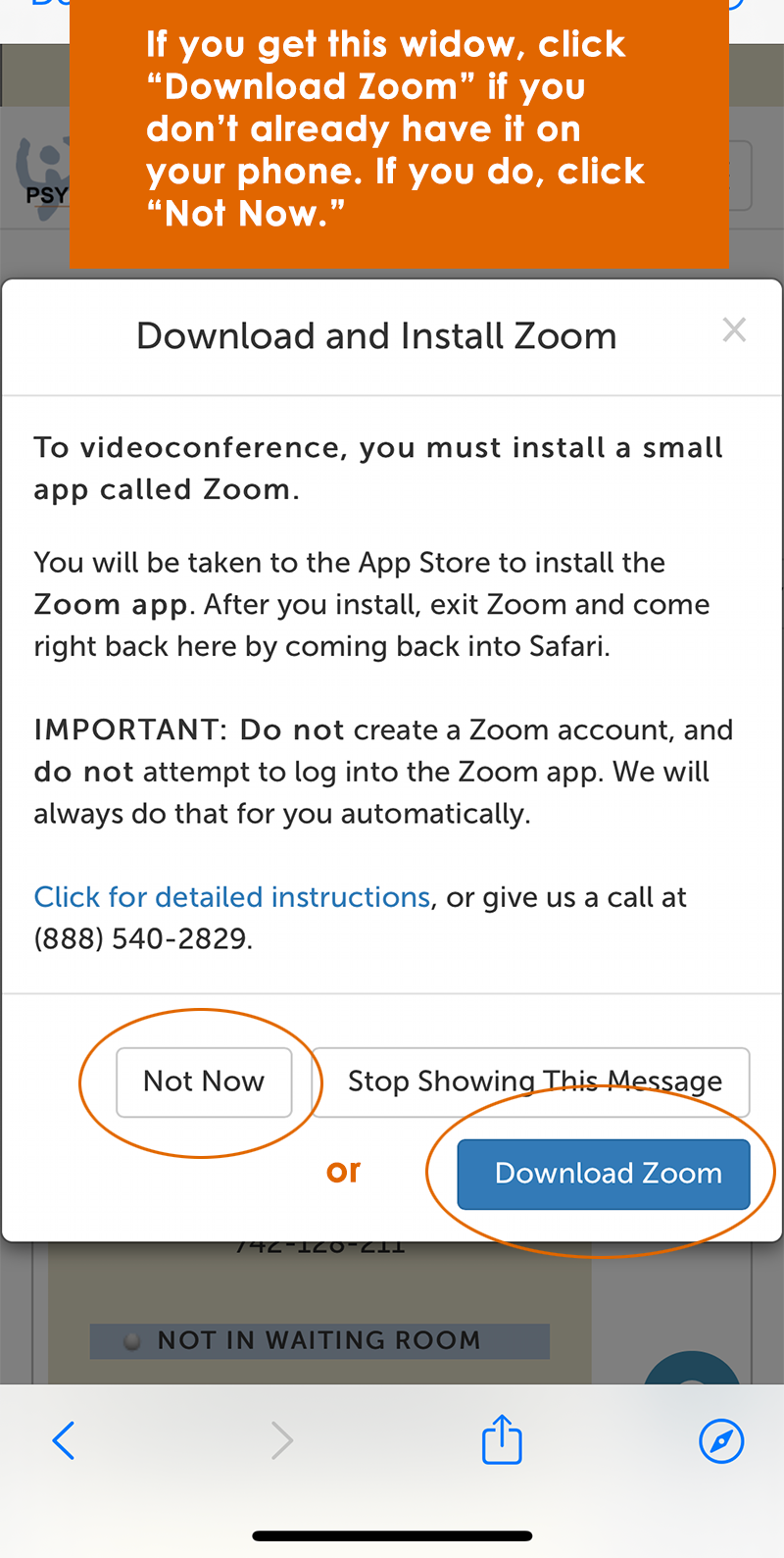Manual Index
-
Chapters
The Manual is divided into seven chapters. Click a chapter title to display that chapter's table of contents in the area below.
PSYBooks Manual
Chapter Seven
Intro to PSYBooks Mobile
What this isThe PSYBooks Mobile app is designed to work on mobile devices, primarily smart phones. Although based on the data in your regular PSYBooks app, PSYBooks Mobile is a completely different app. To access the login page of PSYBooks Mobile, enter psybooks.mobi in your mobile browser. Use the same login information you use in your regular PSYBooks app to sign in to your copy of PSYBooks Mobile.What it looks likeThe home screen of PSYBooks Mobile looks like this: 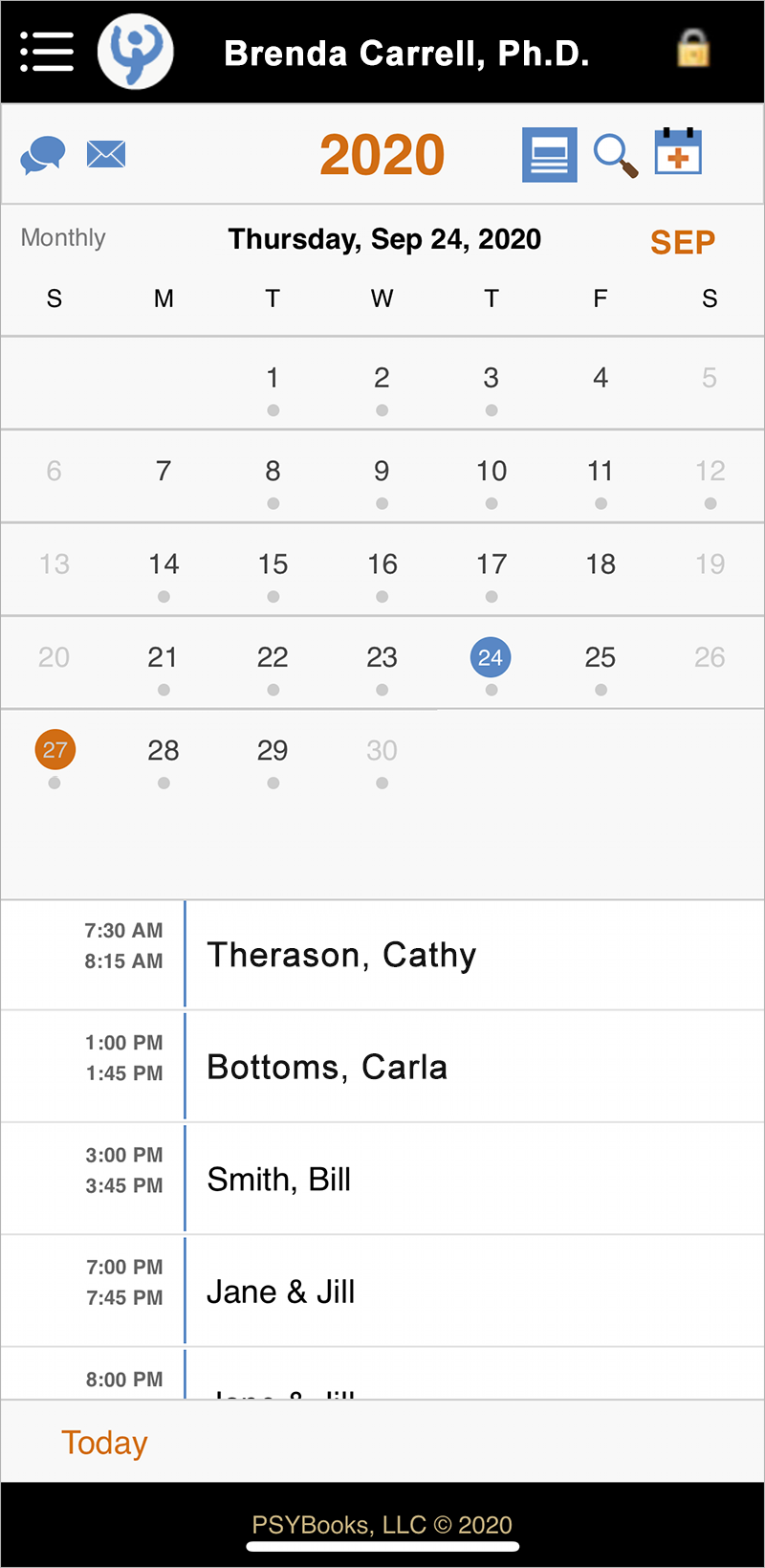 |
Where this isPSYBooks Mobile is found at: |
What Is PSYBooks Mobile?
The PSYBooks mobile app is a separate application for your phone that has the PSYBooks tools you are mostly likely to need when you're on the go. It is not the complete PSYBooks app. Unlike most mobile apps, you don't have to go to an app store and download PSYBooks Mobile. Instead, the app is built with a new technology called Progressive Web Apps – or PWAs. Although PWAs can be accessed with laptops, desktops, tablets, etc., they work especially well on phones. They are quickly becoming extremely popular. In fact, you may be using some PWAs without knowing that you are. For example, well-known apps like Twitter, Pinterest, Spotify and Instagram all currently run PWAs in addition to their regular apps. The PWA technology allows developers to build an app that looks and functions like a mobile app that you'd download from an app store, except that there's nothing to download. This is an especially nice feature for your patients - you don't have to ask them to download an app. If they are Portal Users on your account, they already have PSYBooks Mobile. You just need to give them the URL.
Instead of downloading, you access PSYBooks Mobile with your browser, like you would any other website. Internally, much of the processing that’s typically done via the Internet or a cellular connection is done within the PWA itself, so PSYBooks Mobile will work reasonably well even when the Internet or cellular connectivity is less than desirable. Also, because it's an online app instead of a downloaded one, you're not tied to that one phone. If your phone is lost or stolen, you shouldn't have to worry about a HIPAA breach (assuming that your phone is appropriately protected and/or that you have not saved your PSYBooks username and password in your browser). Also, when you get a new phone, there's nothing to install. Just enter the URL in the new phone's browser, log in to PSYBooks Mobile, and you're good to go.
Because there's nothing to download, if you currently have a PSYBooks account, then you already have a PSYBooks Mobile account. This means that any of the Portal Users on your account, as well as your Admins and other Users can also access their versions of PSYBooks Mobile. This will allow you to interact with all of your Contacts via cell phone in ways that are all HIPAA compliant and secure (including encrypted texting). For anyone with a PSYBooks username and password, e.g., Subscribers, Clients, Persons, Users - it's just a matter of opening their phone's browser, navigating to the PSYBooks Mobile website (psybooks.mobi) and logging in with their unique log in credentials.
How to Access PSYBooks Mobile
The PSYBooks Mobile app lives at a completely different URL than the regular PSYBooks app. That's because it's a completely different website. However, even though the two sites have different URLs and don't look alike, what makes them work together is that they both pull data from the same database. Because of this, data you enter in one automatically appears in the other. In other words, data entered on your regular PSYBooks app will populate your PSYBooks Mobile app and vice versa. You don’t have to enter it twice:
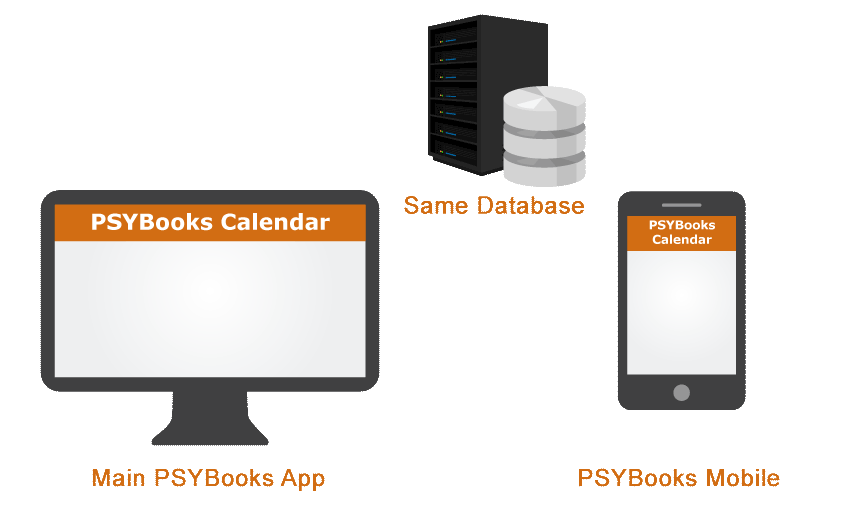
Main PSYBooks App
Regardless of the type of device you're using, you'll access the login page of main PSYBooks app if you enter the URL below in your browser:
(or just secure.psybooks.com)
Although the main app CAN be used on phones, it's not recommended. It's too large and complex a site to be able to fit well on the small screens of phones.
PSYBooks Mobile
Alternately, if you want to access the login page for PSYBooks Mobile - again, no matter what kind of device you're on - use:
(or just psybooks.mobi)
Again, although Mobile can be used on your desktop or tablet, it's really made for use on phones. It's a complementary mobile site designed with the features you're most likely to need when you're away from your office.
Badges & Notifications
Badges & Notifications aren't essential for using PSYBooks Mobile. However, they are some nice additional features that some phones offer. Unfortunately, they don't work on all phones or operating systems. If they're not working on your phone, try Googling your phone and operating system to see if it allows home page badges and/or notifications with PWAs (Progressive Web Apps). Sometimes there's a way to accomplish the tasks on your phone manually. Unfortunately, although the PSYBooks support staff is excellent with understanding and supporting the PSYBooks app (including Mobile), they're not trained to solve issues that are specific to your phone.
Badges
Since PSYBooks Mobile is accessed via a browser rather than downloaded, it doesn't automatically create a badge for your phone's homepage like a downloaded app would. Android phones provide excellent support for PWAs, including allowing PWAs to create badges. When you first access PSYBooks Mobile on an Android device, you should get a screen like this:
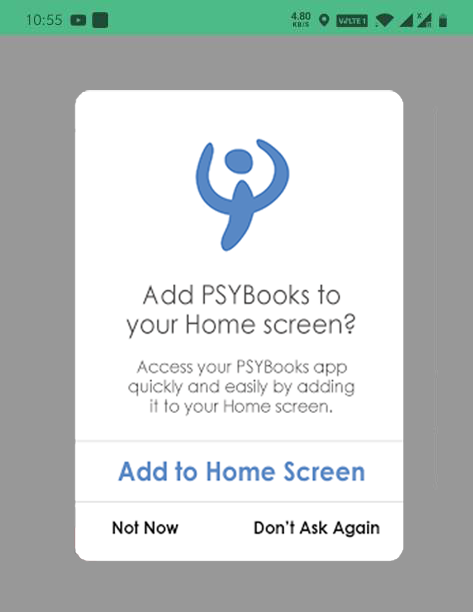
If you press "Yes," a badge will be added to your home screen, enabling you to access PSYBooks Mobile like you would any other mobile app.
Some iPhones can also add badges to the phone's home screen. However, you will not get an automated screen like the above to help you install it. You'll have to do some sleuthing if you want to do it - and not all iPhones have that ability.
Notifications
Notifications are only available on Android phones. Again, the first time you access the PSYBooks mobile app on your Android, you should get a screen like the one below.
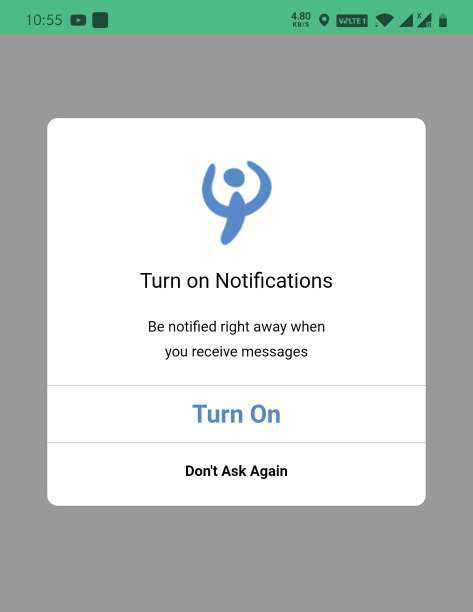
Turning on Notifications will allow you to be notified if one of your clients or other contacts sends you an encrypted text - just like you're notified of regular texts. Again, iOS does not have this feature although they may add it in the future.
What Can I Do On PSYBooks Mobile?
Navigating the App
PSYBooks Mobile has both a black Status Bar at the top of the app and a Global Nav right under it. Both have tools that can be used to get you in and out of the major sections of Mobile quickly. Once you're in an inner section of the app, there will be additional tools for navigating within that section. However, if you ever feel lost, the Status Bar and/or the Global Nav will more than likely have a tool to help you find where you want to go. Although the tools on the Status Bar and Global Nav remain fundamentally the same throughout the app, there are minor changes as you navigate to various sections. The home page of PSYBooks Mobile is part of the Calendar section. The Status Bar and Global Nav on the home page look like this:

Status Bar
As in the regular PSYBooks app, the black status bar appears on each page in PSYBooks Mobile and holds tools you'll be able to access from anywhere:

Numbers in the above screenshot snippet mean the following:
- The Hamburger Menu, which will be discussed below.
- The Home Page button. Clicking the PSYBooks logo from anywhere in Mobile will take you back to the home page.
- Your name.
- The logout button. Although you don't have to logout of the mobile app each time, doing so provides an extra layer of protection.
Since the most likely things you may need to do when you're away from the office are to check (and/or change) your schedule and to communicate with your clients or other contacts, PSYBooks Mobile has two main areas - Calendar and Contacts. The Hamburger Menu gives you access to each of these areas. When you first login to PSYBooks Mobile, you'll be on the Calendar page. However, if you want to acces Contacts, you can use the Hamburber Menu on the black status bar at the top left:
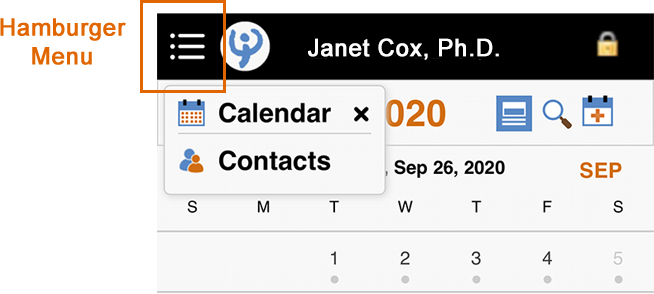
Global Nav
The Global Nav on the home page of PSYBooks Mobile looks like this:

Since the home page is within the Calendar section of the app, the last four tools on the Global Nav, #3 - #6, are actualy Calendar tools. The first two, Chat and Email, are tools you may need frequently that can be accessed from any section. The tools on the global nav of the PSYBooks Mobile home page are:
Each will be discussed below, or you can click the links above to view the one you want.
- Chat/Encrypted Texting

Chatting on PSYBooks Mobile is the equivalent of encrypted texting and is a HIPAA compliant way to text with your clients. Since texts/chats are considered part of the patient's medical record, using PSYBooks Mobile for texting also automatically preserves a copy of each patient's texts for you, right in the app.
Clicking the Chat Tool takes you to the "Recent Chats" page to allow you to check or follow up on any encrypted texting conversations you may have had. From that page, you can access all other chat tools, including starting a new chat. If you've been chatting a fair amount, your Recent Chats page might look something like this:
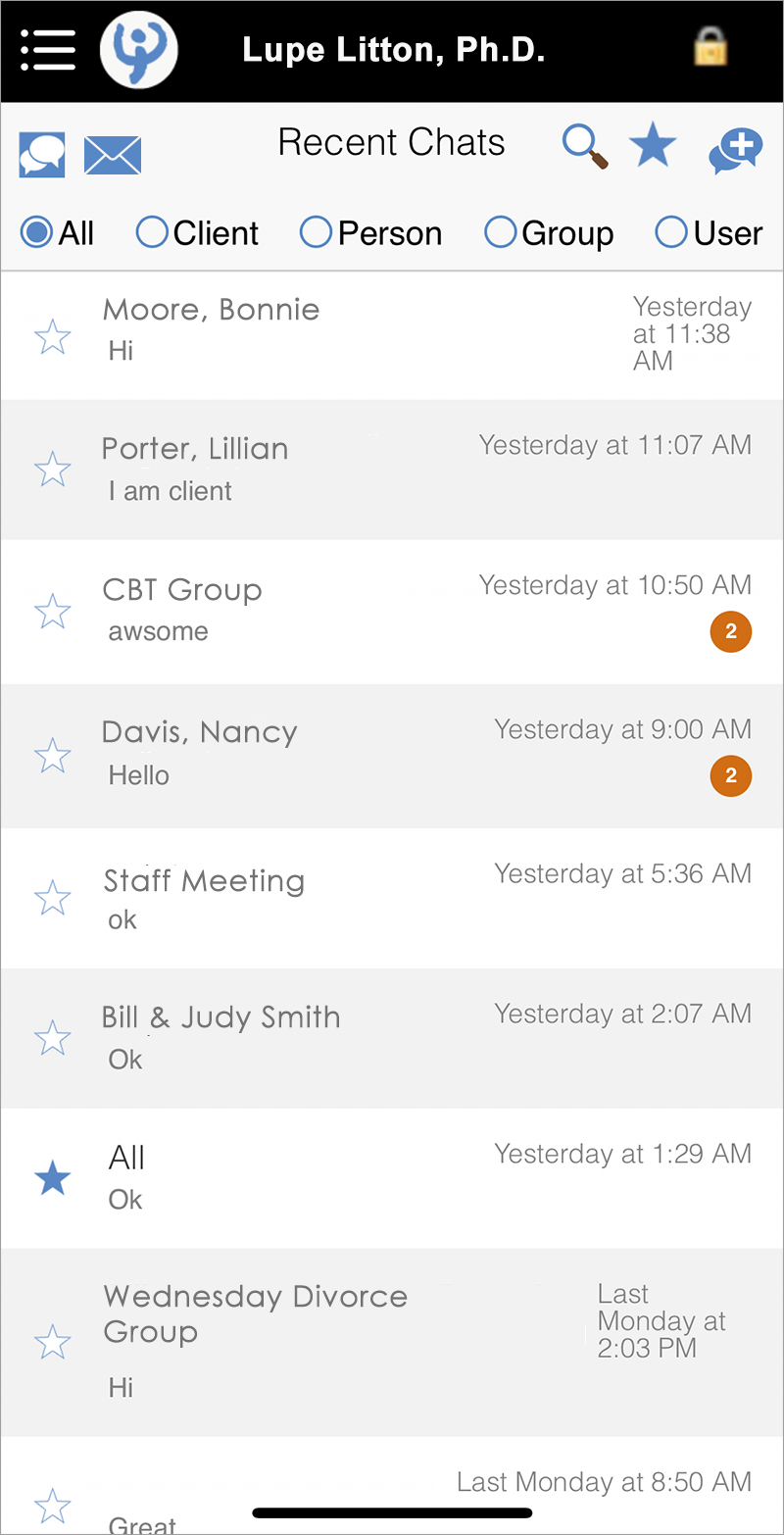
If you press one of the recent chats listed in the screenshot above, you can see the entire chat with that particiular individual or group.
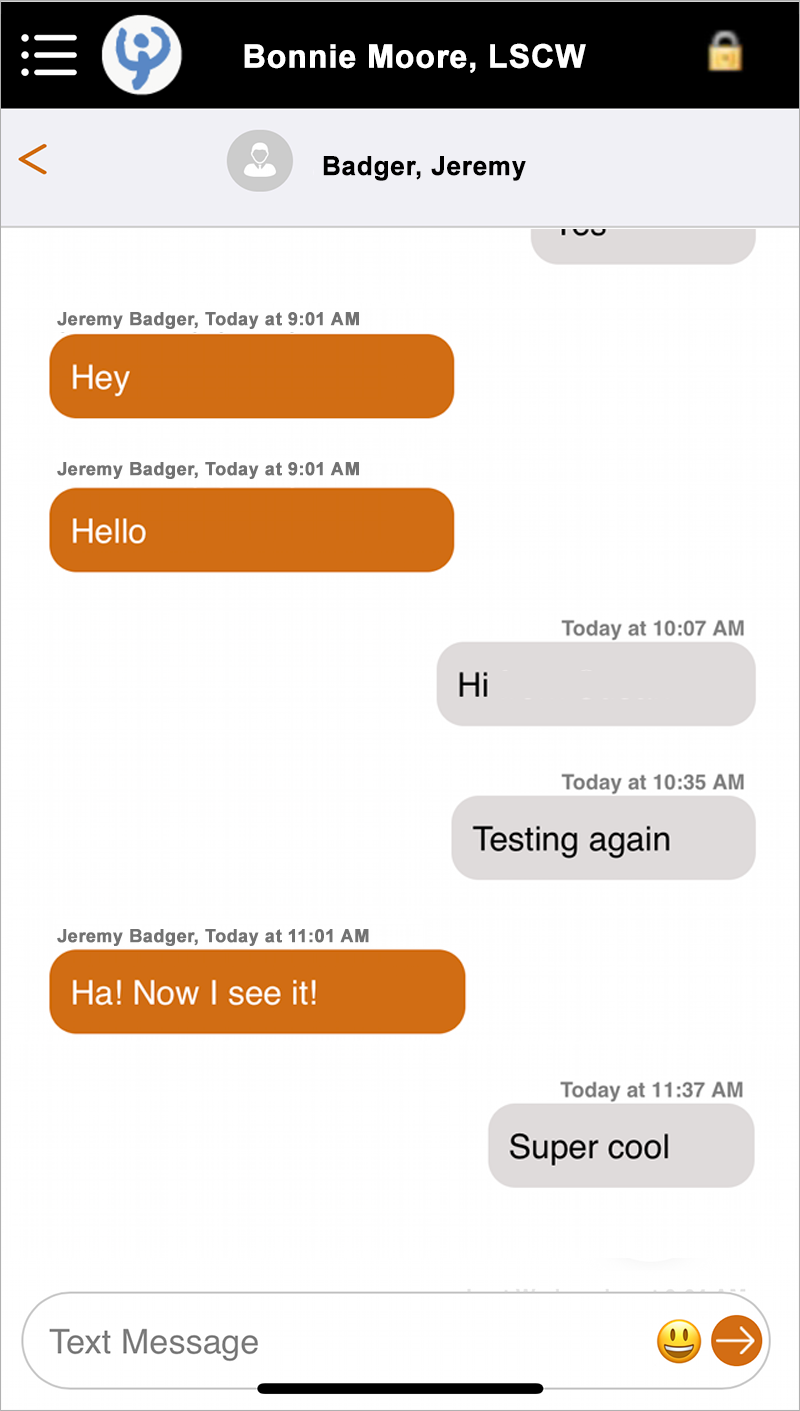
Notice that chats/encrypted texts can be done with any of your contacts that can log in to PSYBooks Mobile. This would include anyone who's a Portal User plus Admins, and other Users and Subscribers. If you see couples and have them listed as a PSYBooks Group, you'll be able to text both at once by entering their group name. If the user's phone is set up to receive notifications, they'll get a regular (non-encrypted) text telling them they have a new message in their PSYBooks Mobile account. Once they log in, they'll be able to see a screen with the encrypted text/chat.
Notice that the chats section of PSYBooks Mobile has its own global nav:

The tools on the Chat Global Nav are:
- Selected Chat Tool

PSYBooks Mobile uses blue backgrounds with white icons to indicate that an area is selected. The same thing is happening here. We're in the Chat area of Mobile, so the Chat Tool is in its selected form. It will stay this way as long as you're on a page that's within the Chat area. Clicking the Selected Chat tool deselects it and you'll be taken to the home page of the app.
- Search Chats

The Search tool in PSYBooks Mobile is context-dependent, meaning that what it searches depends on the area you're in at the time you click it. When you're in the Chat section, clicking on the Search tool will produce a drop-down that will look something like this:
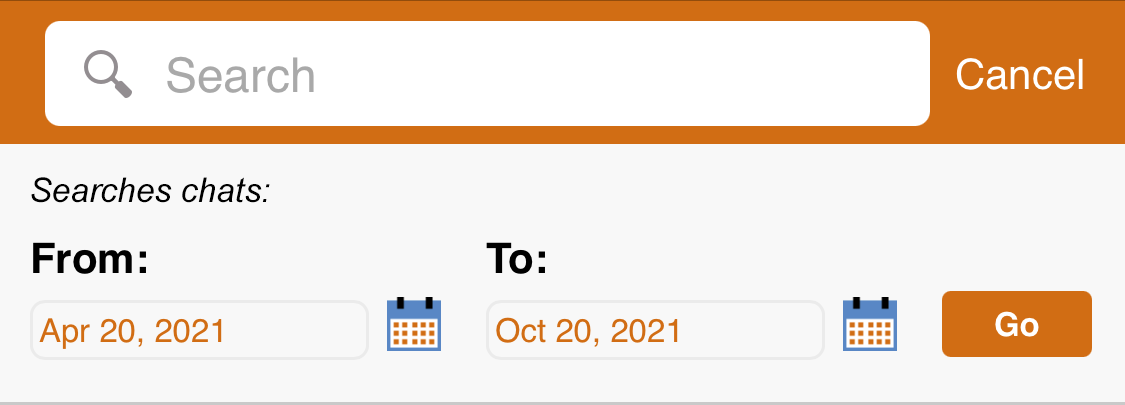
The search box is an auto-complete so when you start typing in it, you'll be able to see all chats that match what you've entered. There are tools to allow you to change the search dates to whatever you want. The default dates are three months before and three months after the current date.
- Chat Favorites

Clicking the Favorites tool when you're in the Chat section filters your chats so it only shows those you have marked as favorites. In the screenshot below, the regular "Recent Chats" is on the left. You can see that the Favorites tool in the Global Nav is in the non-selected state. Also, notice that some of the chats that are listed have been marked as favorites (the blue star) whereas others have not (the white star with a blue outline.) On the right is the page you would see if you clicked the Favorites tool in the Global Nav. Notice that the page header has changed to "Chat Favorites," the Favorites tool is in the selected state, and the only chats listed are those that have the solid blue stars, indicating that they've been favorited:
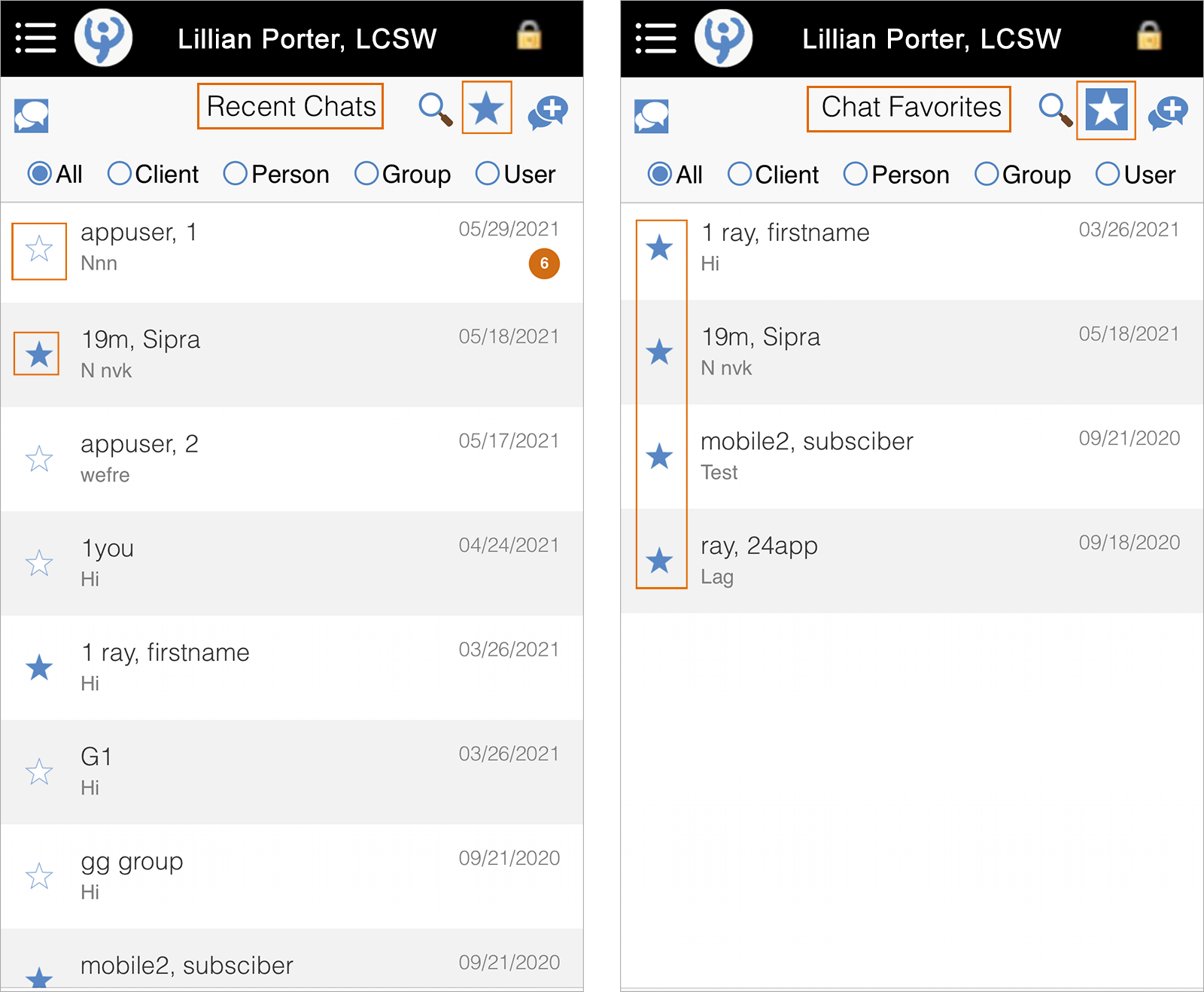
The stars to the left of a chat can be toggled off and on as often as you like - enabling you to mark and unmark chats as ones you want to remember or highlight at any time.
- New Chat

Clicking the New Chat tool opens a list of your contacts with an enabled chat button by their name:
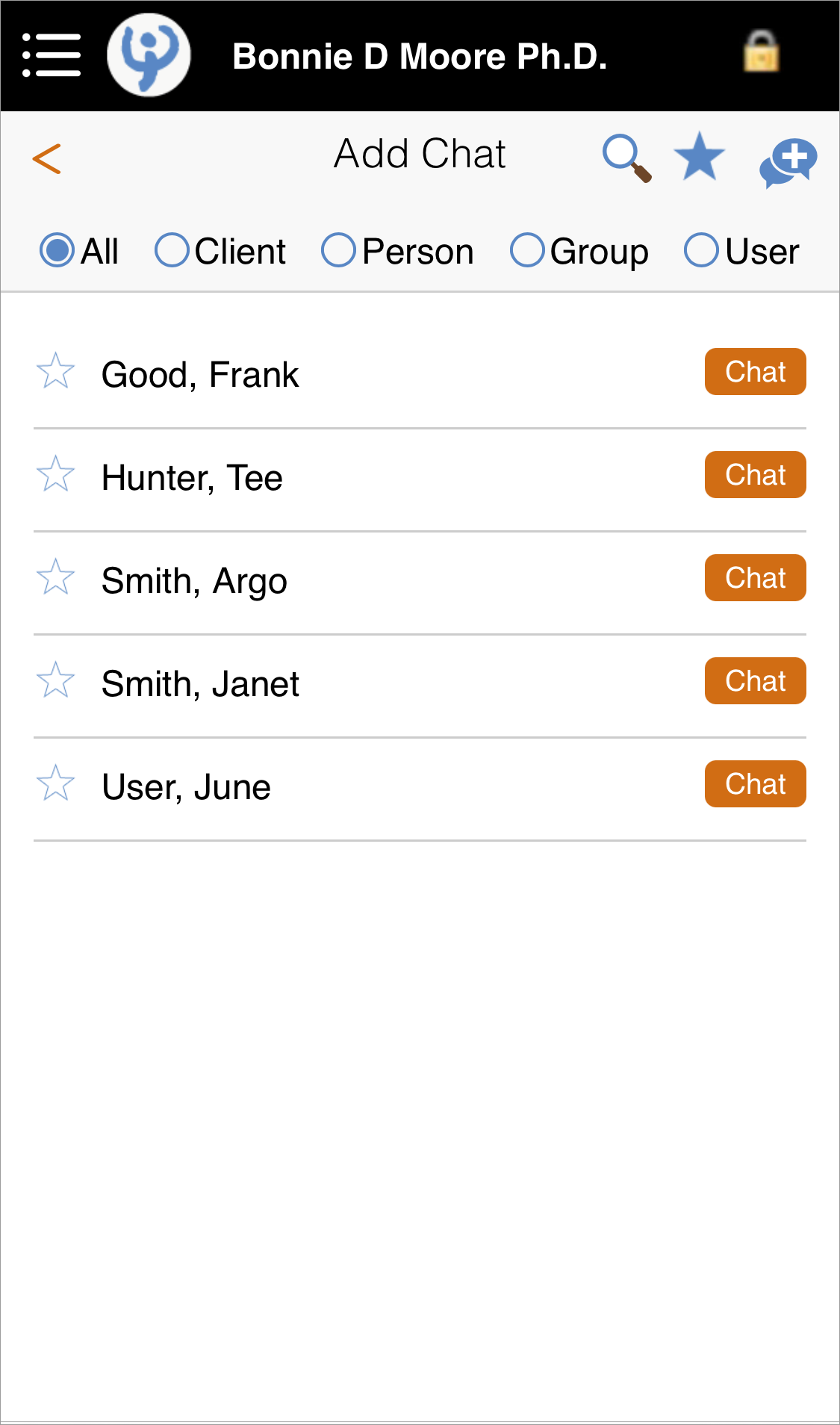
If your Contacts list is long, you can use the filters below the other tools to select only those Contacts who are clients, other persons, groups or users.
- Chat Filters

The filters work on all pages in the Chat section. You can filter your Recent Chats, your Favorites or, as discussed above, your contact list so you can start a new chat with the person you want.
- Selected Chat Tool
- Email

When you click the Email icon, you're taken to your Unread mailbox. Note that, unlike the web app, the home page of PSYBooks Mobile Email includes ALL unread email, even email that is assigned to various folders you may have established for your Portal Users. It looks like this:
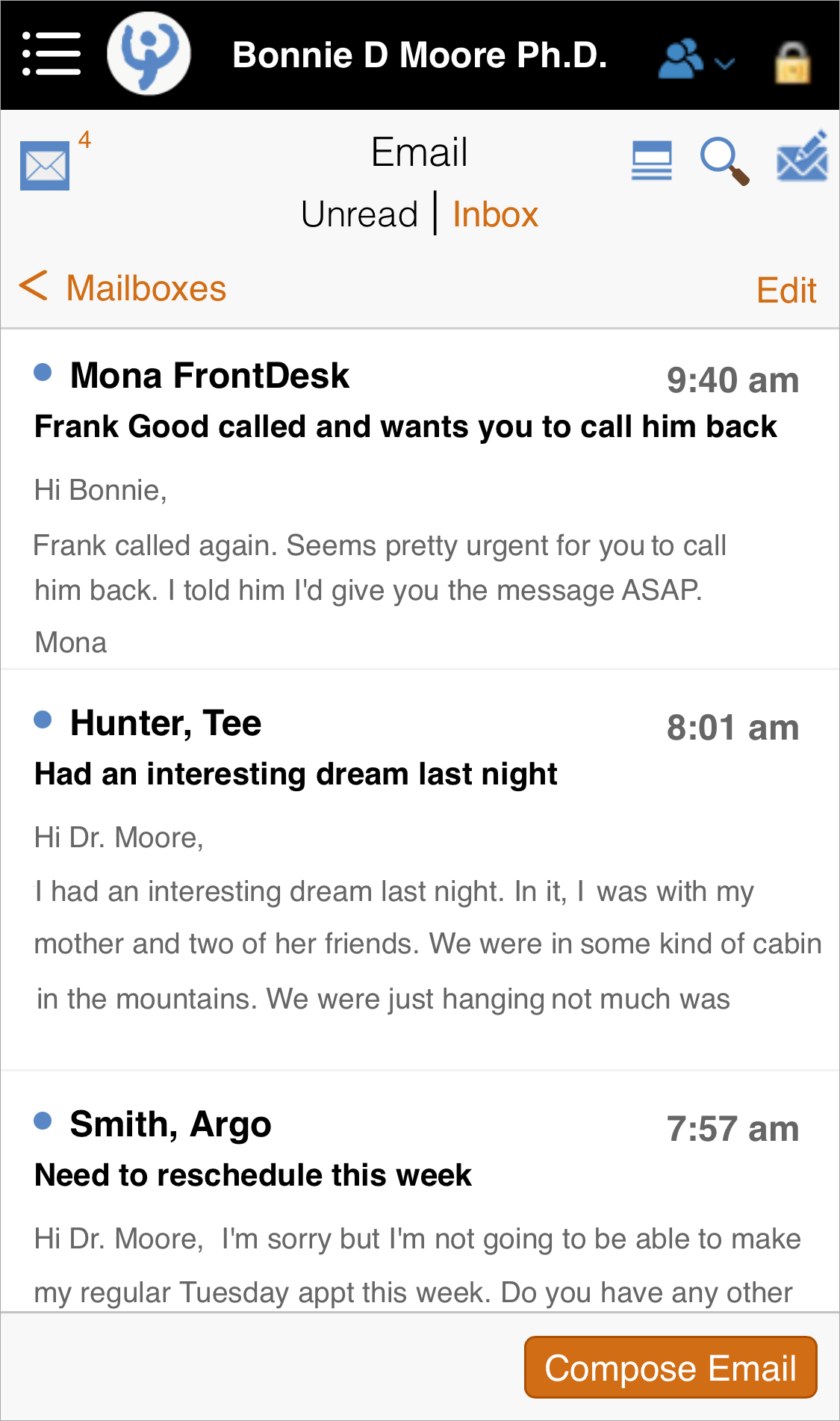
At the top of the landing page are two links that allow you to toggle between Unread mail and your Inbox:
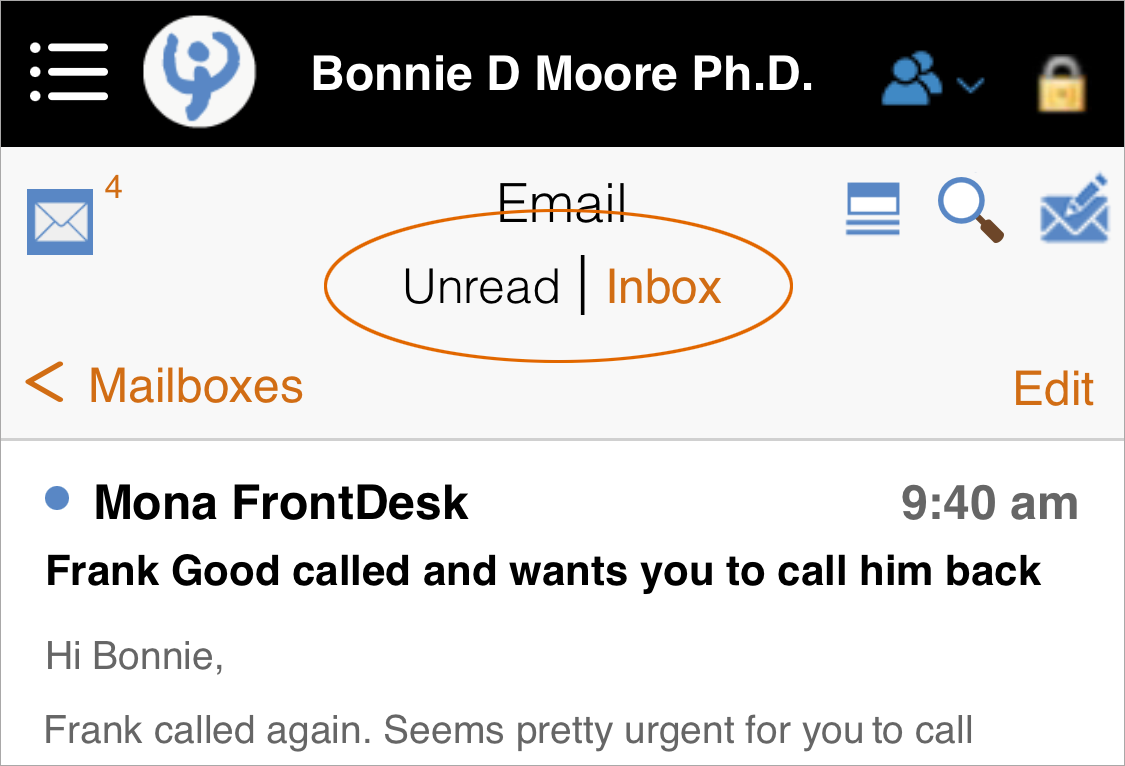
The Inbox is the equivalent of the Email landing page in the web app, in that it contains all email that hasn't been assigned to a specific folder, whether read or unread. Blue dots, such as can be seen beside Mona FrontDesk's name above, are used to indicate an email that is unread.
The Email section of the app has its own global nav with a series of tools that remain the same on each page within Email. In addition, there's one extra email tool in the black status bar across the top:

- New Status Bar Tool: Admin Email
The new tool on the black Status Bar allows you to view the email of Admin Users on your account. If you do not have any Admin users, you will not have this tool. If you do, clicking the Admin's name from the dropdown will actually take you OUT of your email account and IN to theirs. In other words, you'll be able to review any emails they've sent or received:
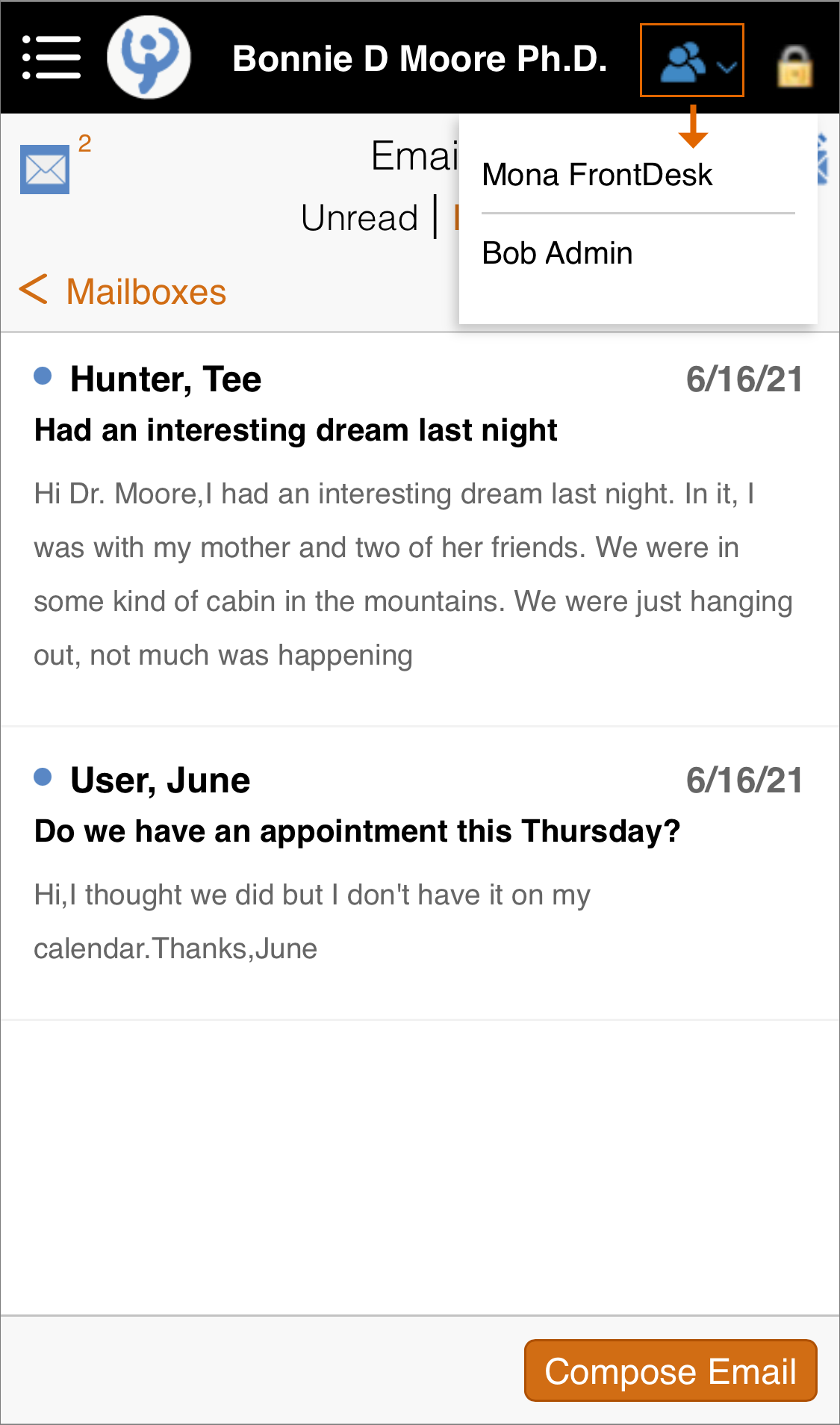
Other tools on the Status Bar are not specific to Email and are discussed in the Hamburger Menu and Status Bar section above. The rest of the email tools are on the Global Nav of the Email section and will be discussed below.
- Selected Email Tool with Counter
When you're in the Email section of PSYBooks Mobile, the email icon in the Global Nav changes to the selected view of the email icon (blue background behind the white envelope). Also, when you have unread email, a counter appears to the right of the icon:
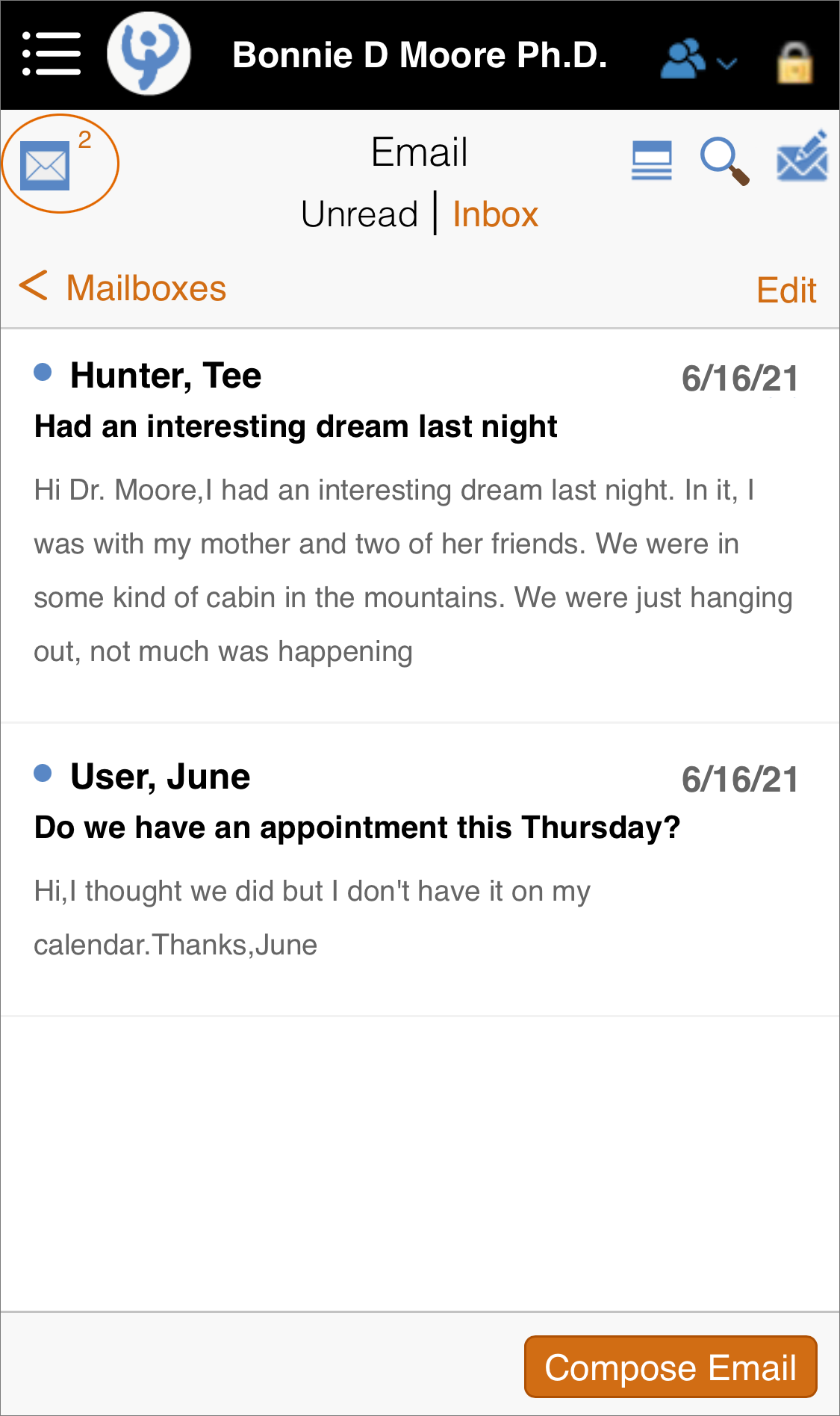
Clicking the selected email tool essentially deselects it, which takes you out of the mail section and back to the home page of the app.
- Search Email

As we saw in the Chat section, search tools in PSYBooks Mobile are contextual. That means that when you're in the Email section and click the Search tool, you get a dropdown with filters that specifically pertain to email, allowing you to select a date range and also whether you want to search All, only the Subject or only the Recipient:
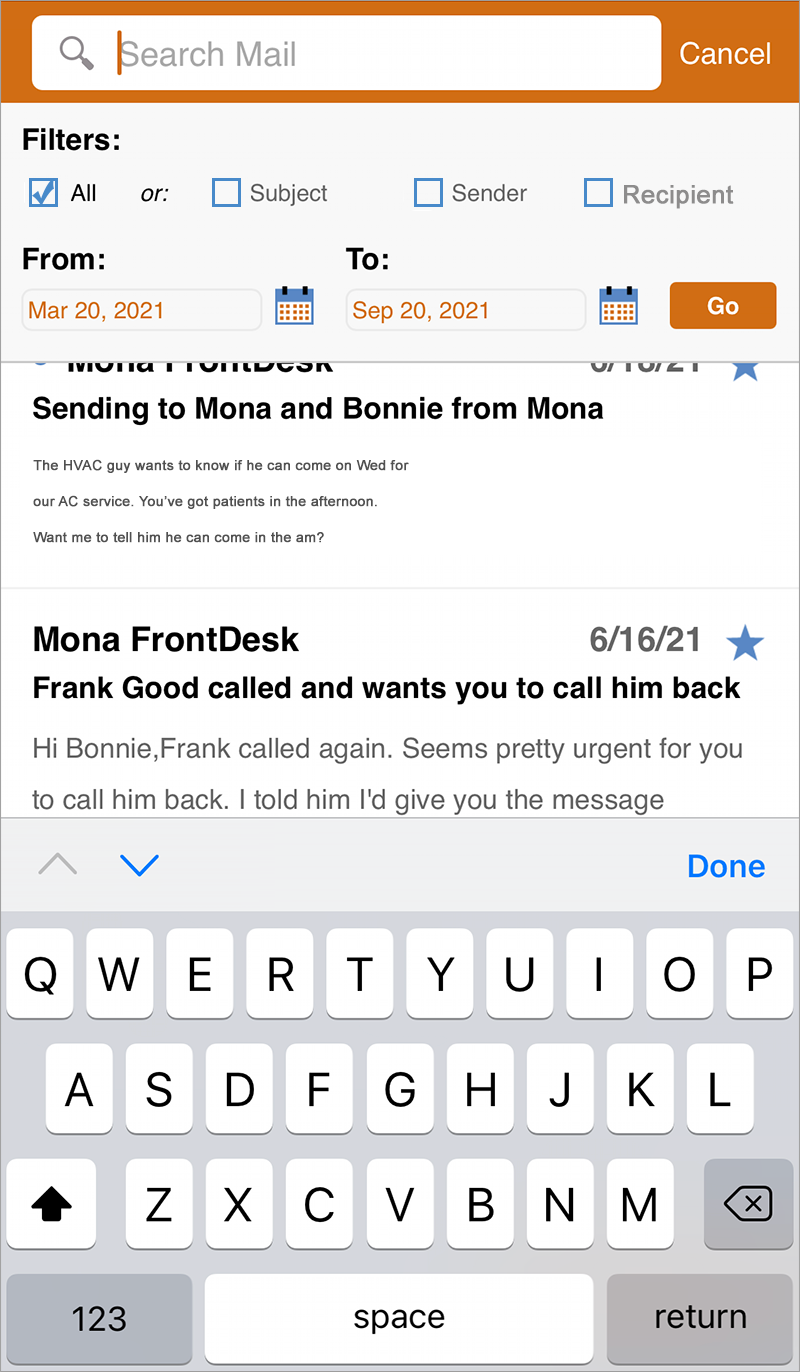
- Compose Email
The Compose Email tool looks like this:

When you click the Compose Email tool, the form that opens looks like this:
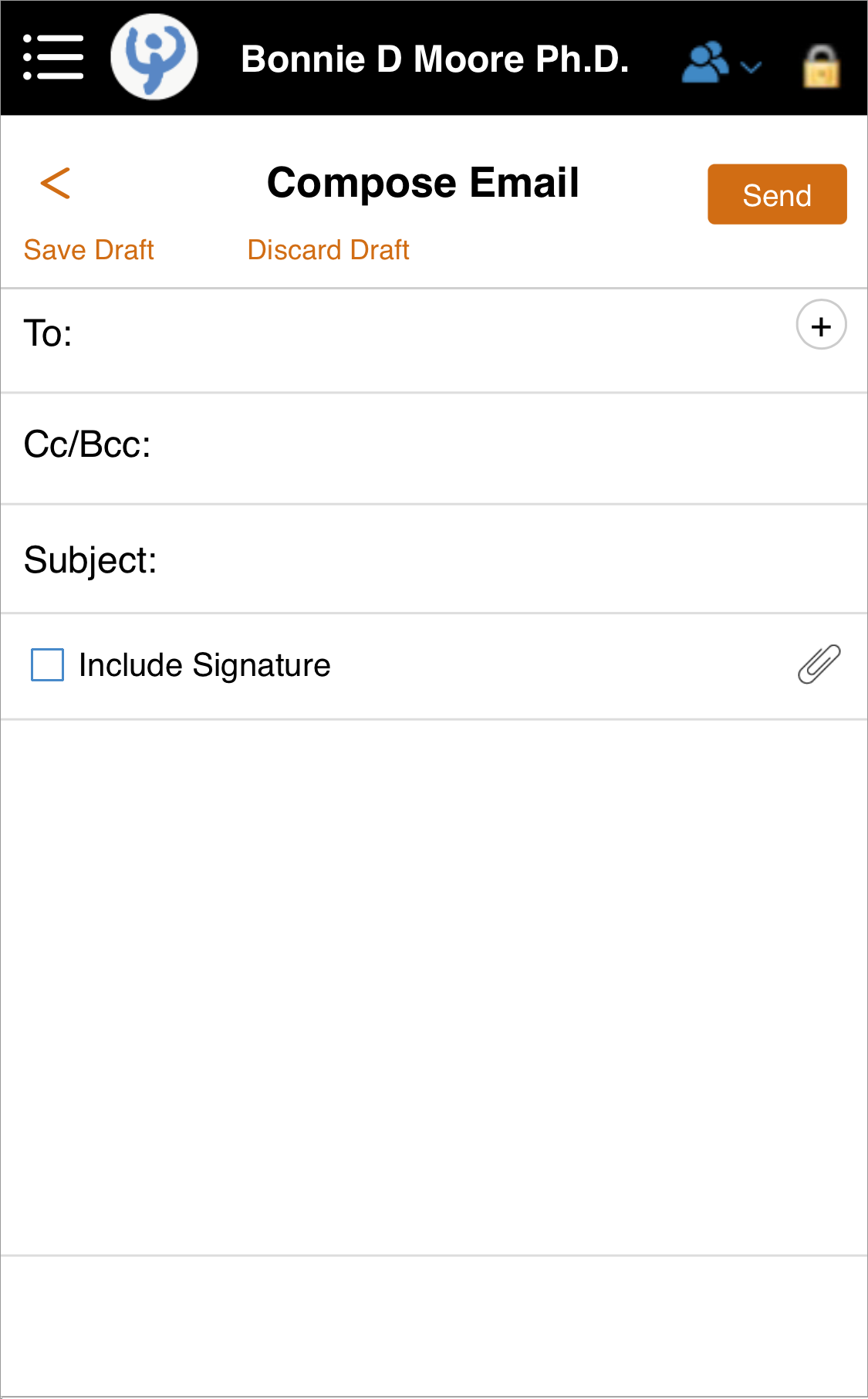
There are two ways to add recipients to the "To," "CC," and "BCC" rows. You can just start typing and the app will autofill for you, narrowing down the options from your contact list:
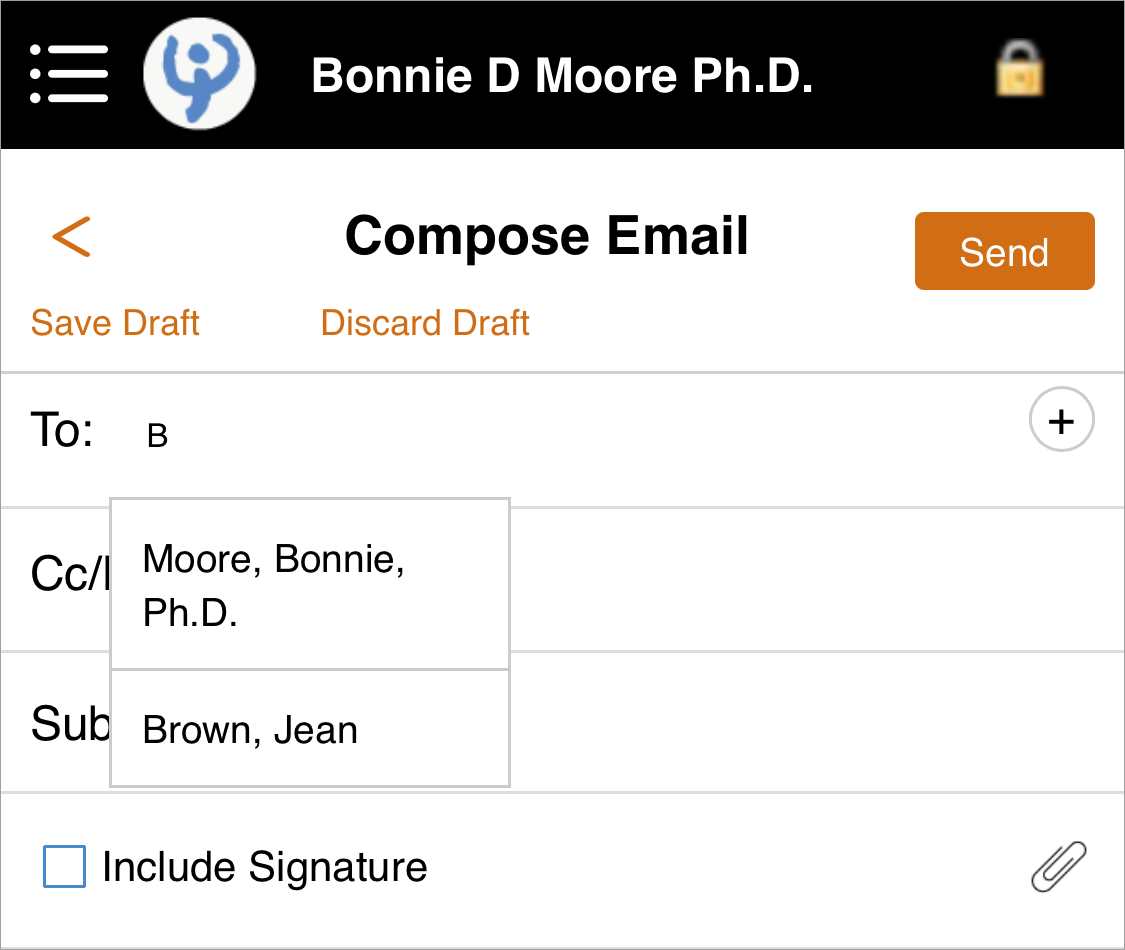
You can also use the + with a circle around it at the end of the row to open your contacts and choose the contact(s) you want:
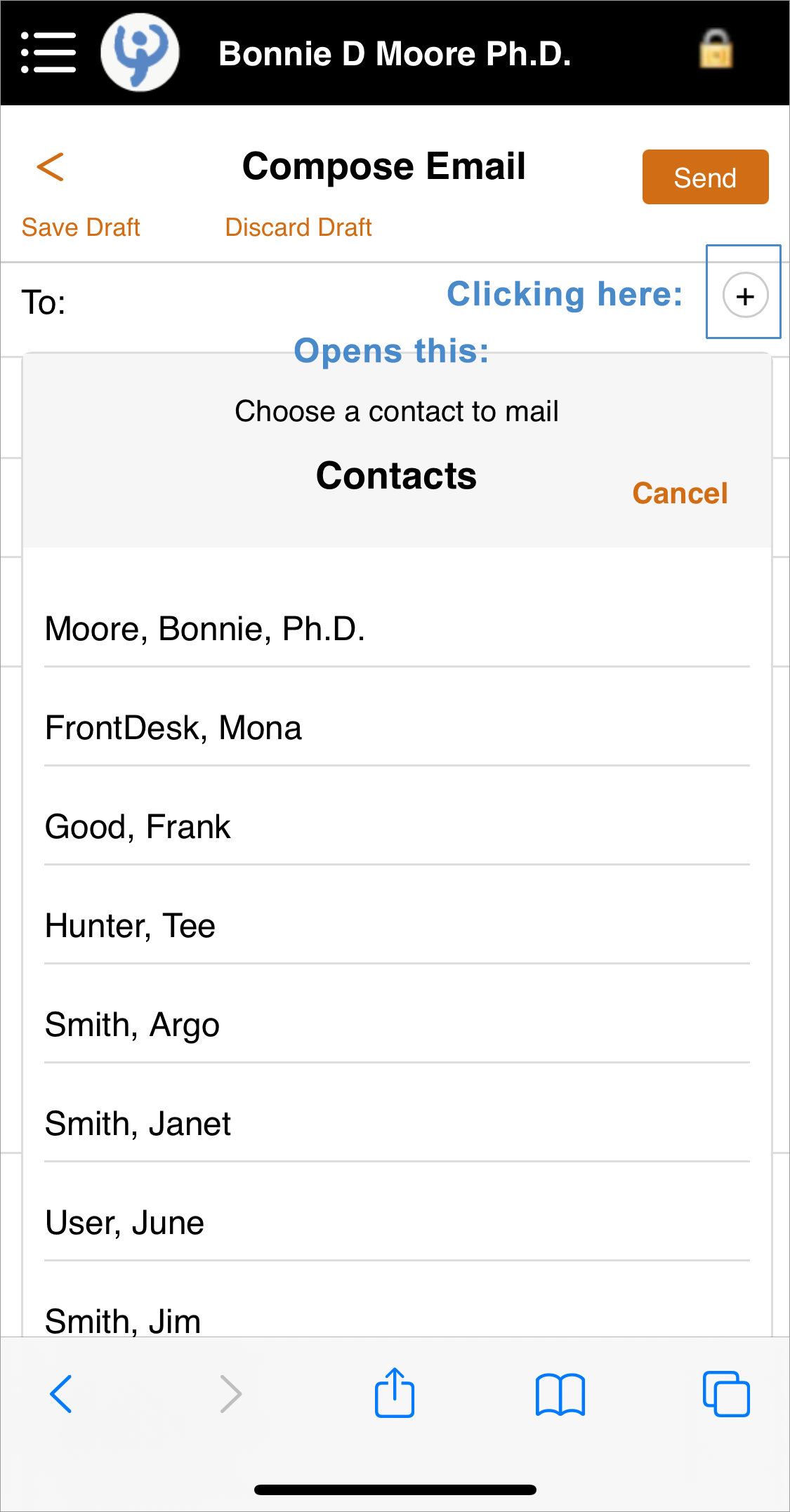
Although you can use either method, if you need to add several recipients, the Contacts tool may be a little easier.
In addition to the global nav email tools, there are tools for working with individual emails.
- New Status Bar Tool: Admin Email
- Calendar Tools
The remaining tools on the home page Global Nav are mostly related to the Calendar. We'll cover each below.
- Selected Year

This shows you the selected year of the appointments you're viewing. In most cases, it will also be the current year. Also, as in the regular PSYBooks app, orange text typically indicates a link. That's true here. Clicking the year link will take you to the yearly Calendar view which looks like this:
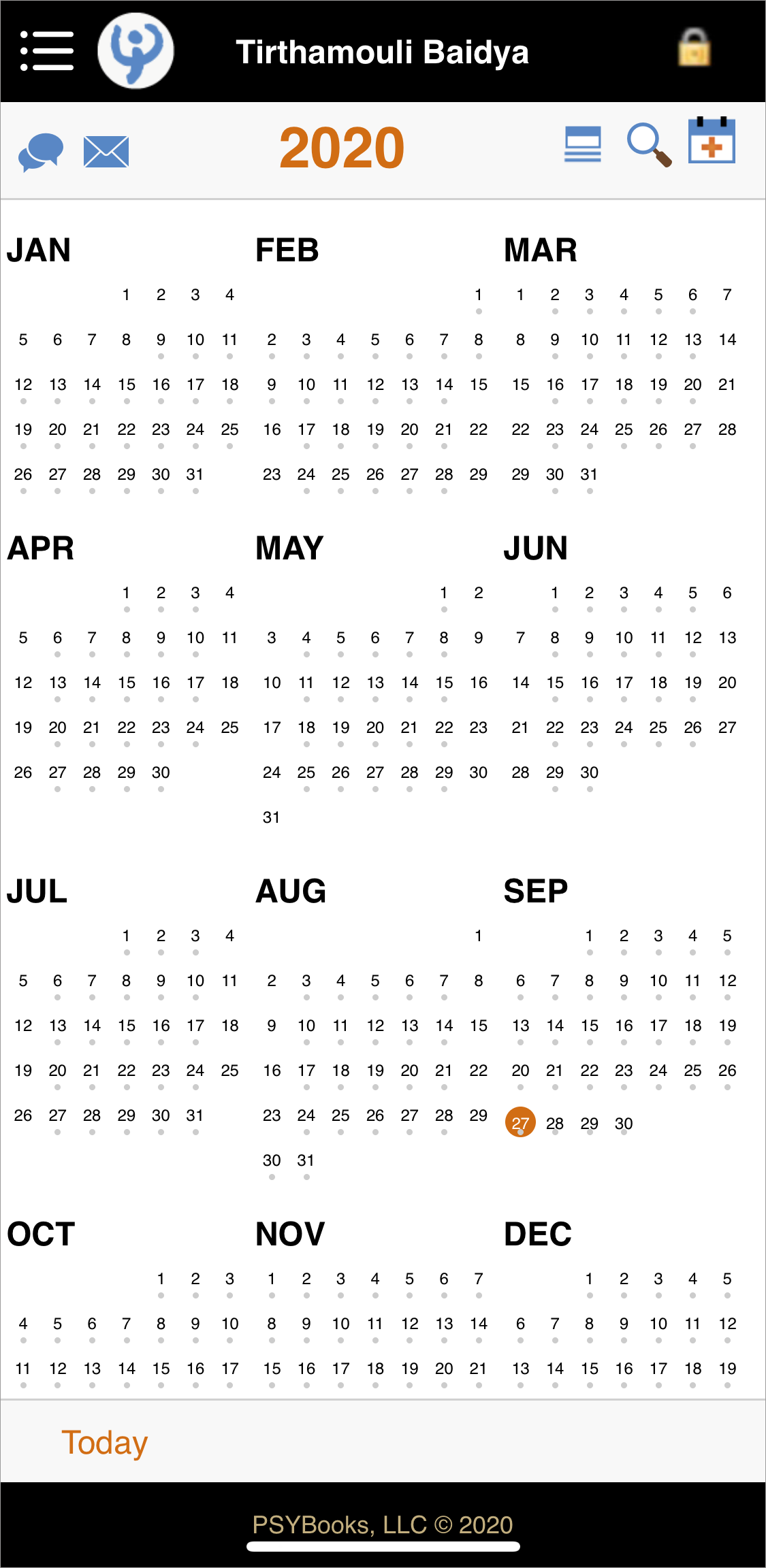
You can swipe left or right on this page to access previous or future years. Also, if you press a date, you'll be taken to that date on your calendar.
- Split Screen Toggle

This tool always keeps you in the split screen condition we saw on the home page (i.e., calendar on top - your schedule for that day on the bottom), but also, pressing it toggles between a monthly view of the calendar or a weekly one. The tool state shown above (with the blue background) is the monthly view, which is what's shown on the home screen. However, if you press it, the state of the icon changes (the blue background disappears) and only the current week is displayed. This may be helpful in enabling you to see more of your schedule without having to scroll.
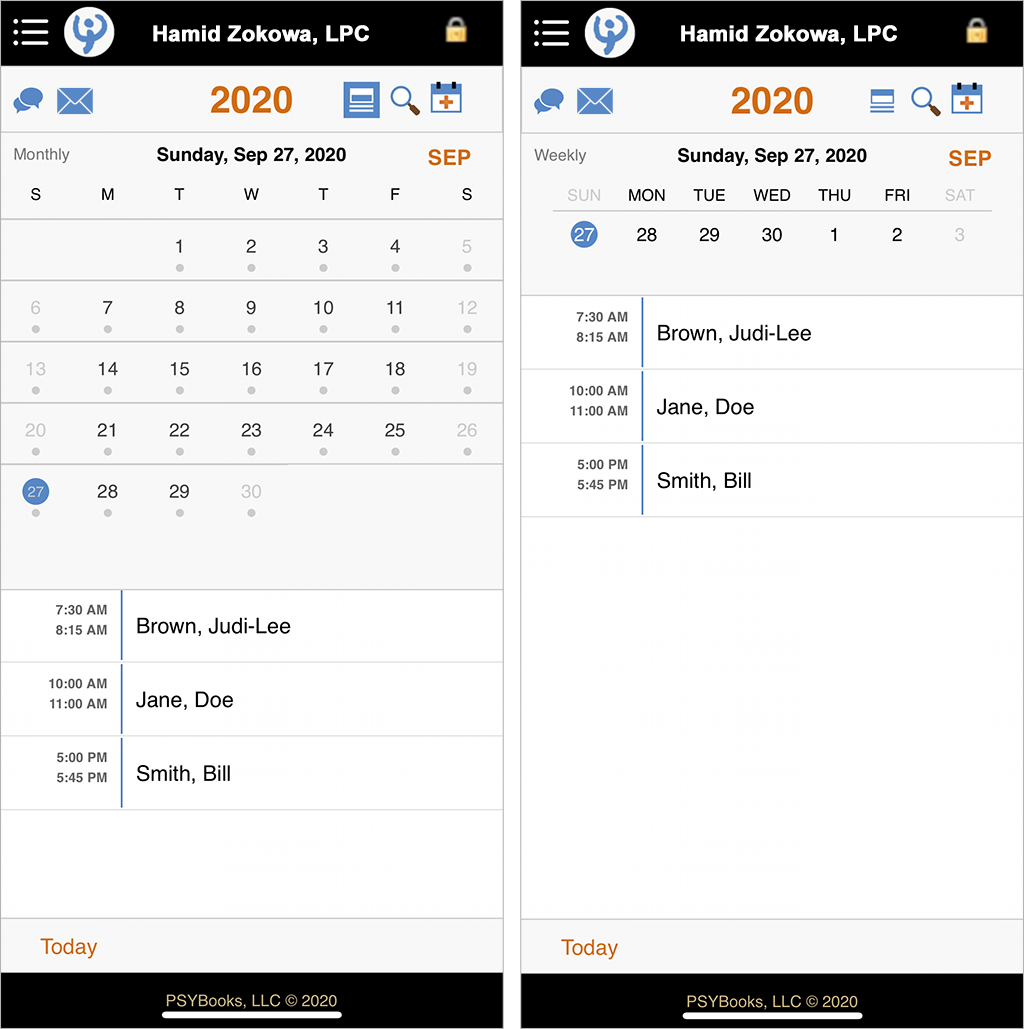
- Search (General)

The Search tool appears on the Global Nav of most areas in the app. It's context-dependent in that it searches the area you're in at the time. When you're on the home page, Search looks through both your Calendar and your Contacts. When you press the Search tool, a new area drops down. From most places in the app, the search window looks like this:
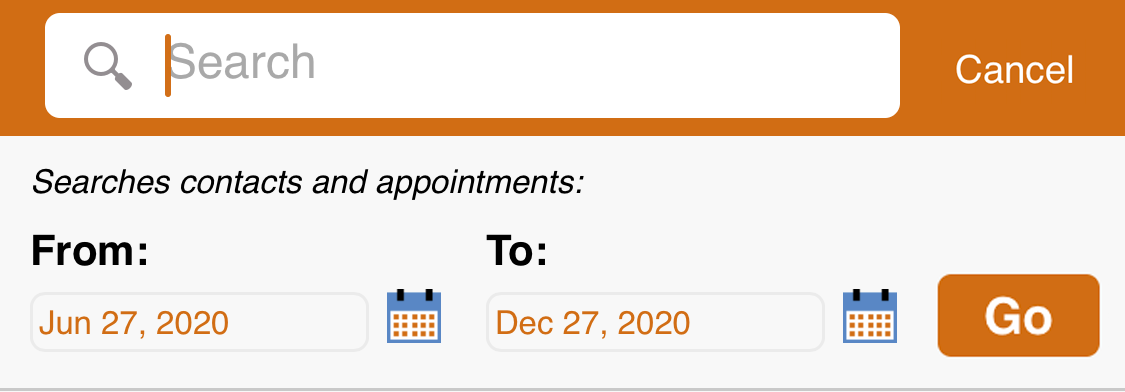
Notice that both contacts and appointments will be searched and that you're given default beginning and ending dates. The default dates are three months before and three months after the current date. However, the dates are orange, meaning that they're links allowing you to change them. (You can also press the calendar to change a date - that does exactly the same thing as pressing a link.)
Once you get your dates the way you want them, you can enter as little or as much as you like in your search string. For example, the screenshot below is what was pulled up just by typing the letter "B" and pressing Go:
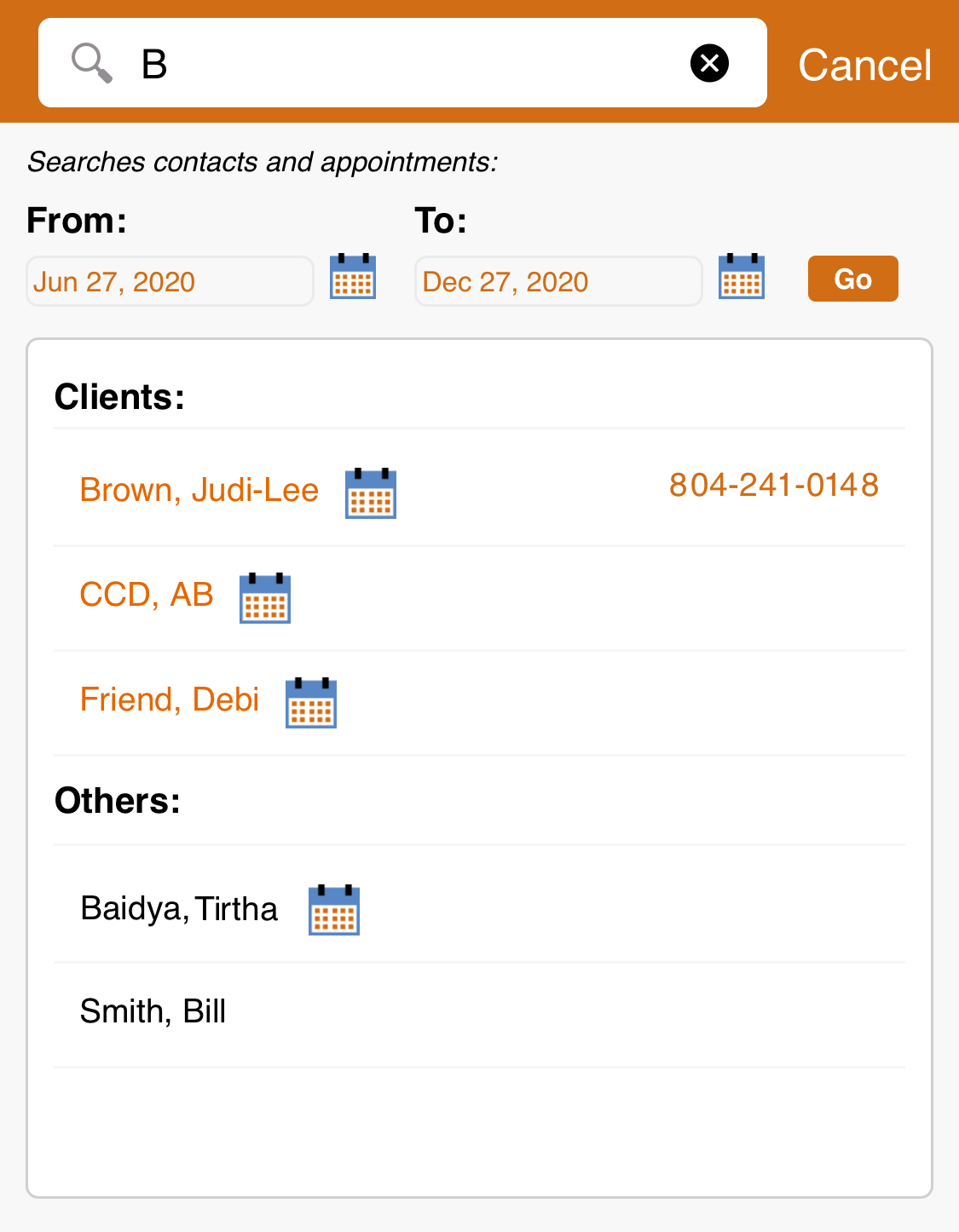
Notice that the search display is divided by Clients vs Others. "Others" might be other People, Events, Groups or Users you've added to your PSYBooks app. It could also be other PSYBooks subscribers if you have a GOI or Group account. Client names are links, which go to the Edit Client form. The calendar icons are used to indicate which of the contacts have appointments on your calendar during the date range that was searched. In the screenshot, Bill Smith does not have any appointments during that time frame but everyone else does. Clicking a calendar icon by a person's name will show the appointments for that contact that fall within the selected date range:
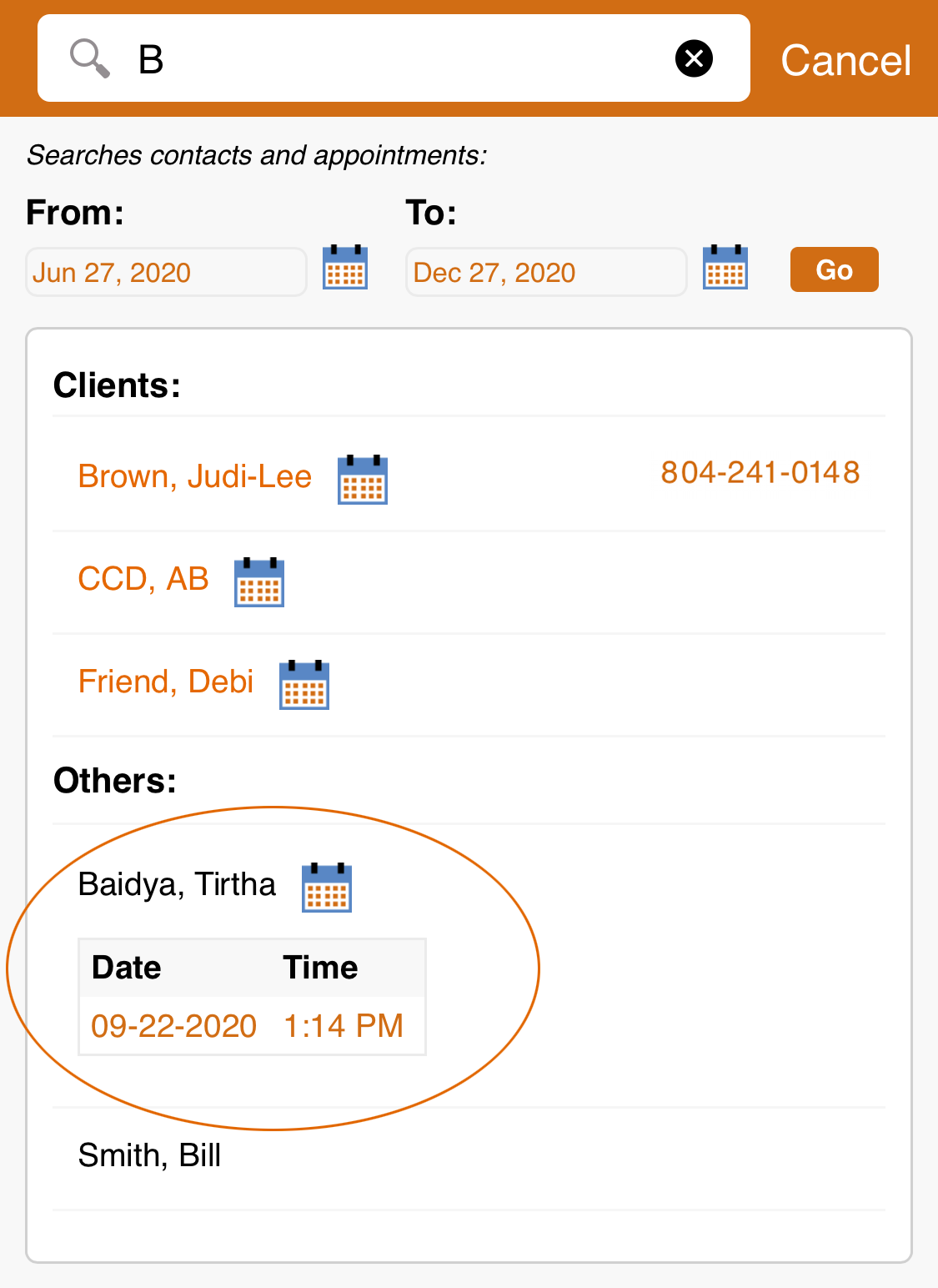
Any contact that has at least one phone number will also have the first phone number listed for that individual shown in the search results. Clicking the phone link will open a new row with a phone icon which allows you to call that person:
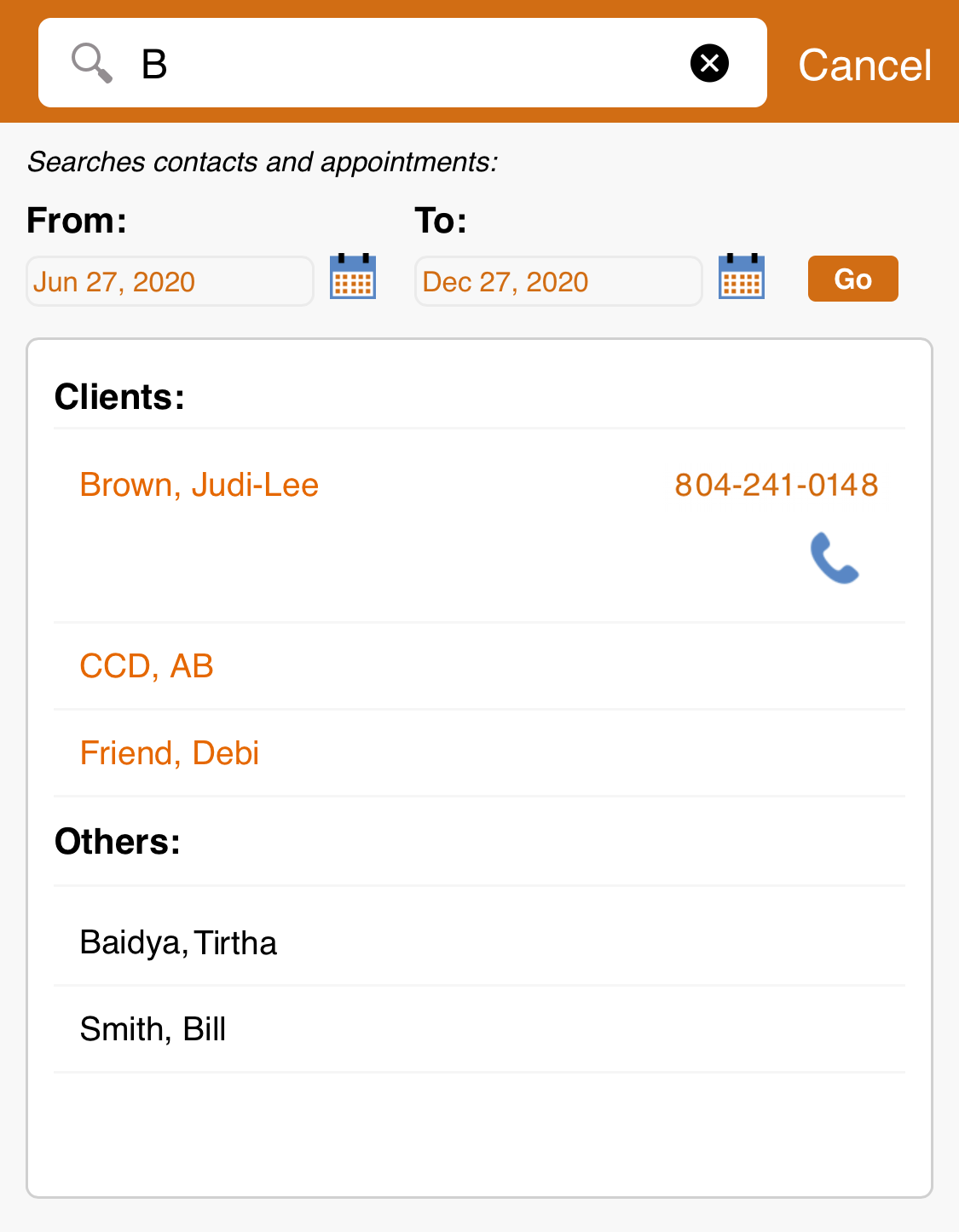
- Add Appointment
The Add Appointment tool can only be accessed from the Calendar section of the app. However, since the home page of Mobile is a Calendar page, the tool appears on the Global Nav you see when you first open the app.
You can easily add appointments with your phone using PSYBooks Mobile. When you press the Add Appointment tool on the Calendar global nav, the form that opens looks like this:
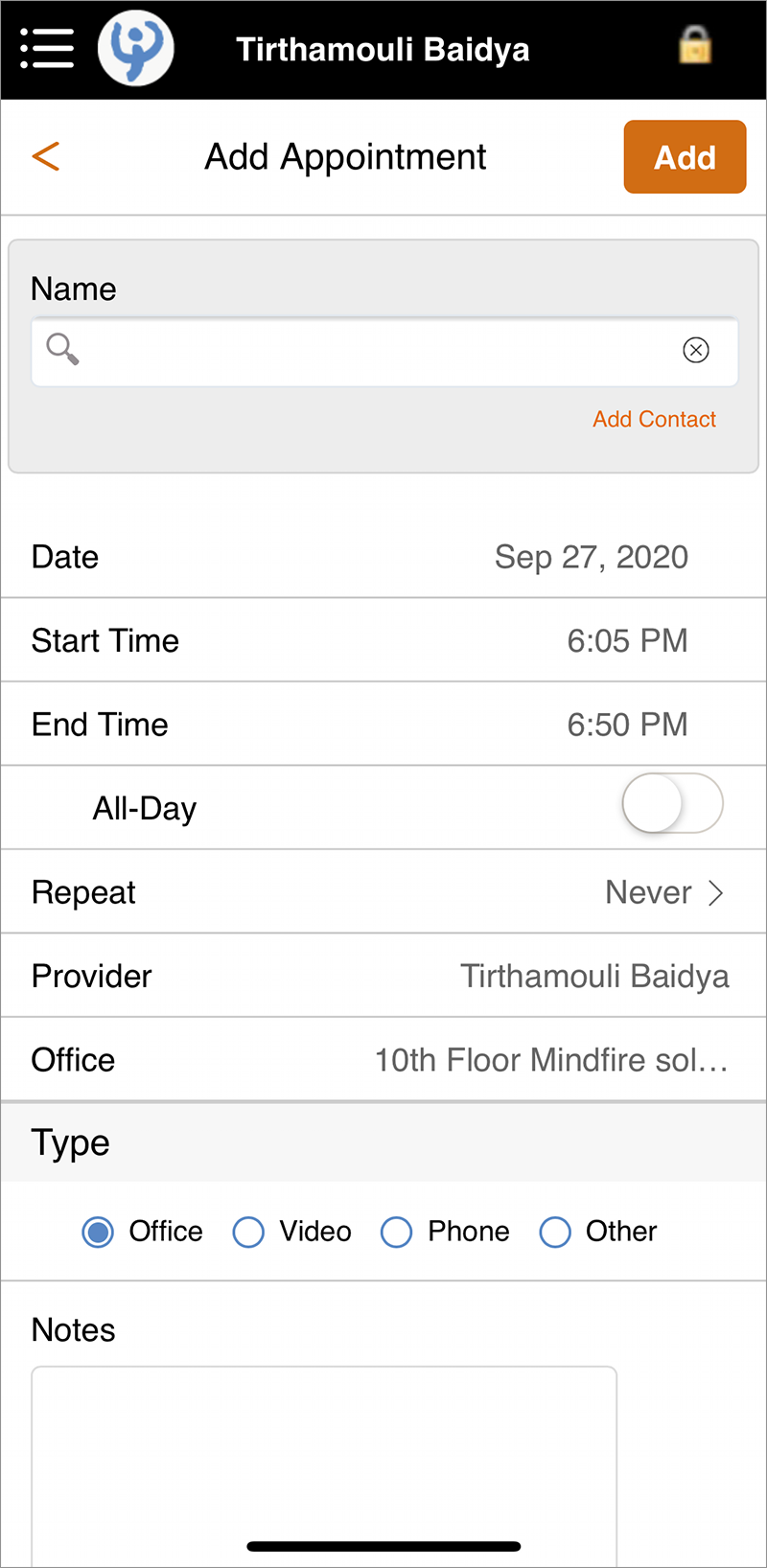
The first thing to notice is that the field where you would normally add the contact's name is designated as a search field. In the screenshot below, the letter B was typed, and all the contacts with a "B" auto-populated the area below the search field:
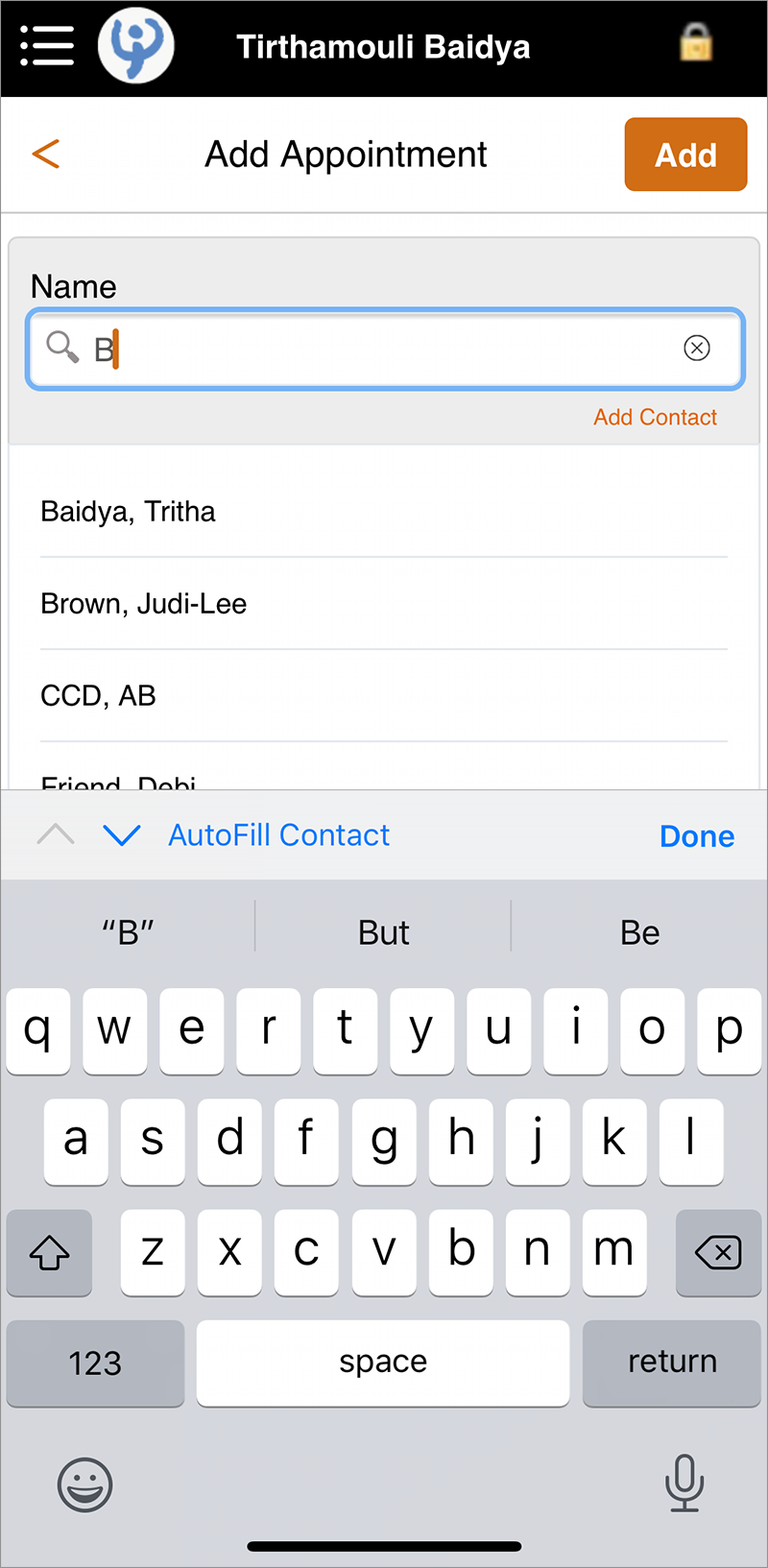
If you see the contact you want, you can just select it. Or, if you type something that doesn't exist in your database, you'll be asked if you'd like to create a new contact:
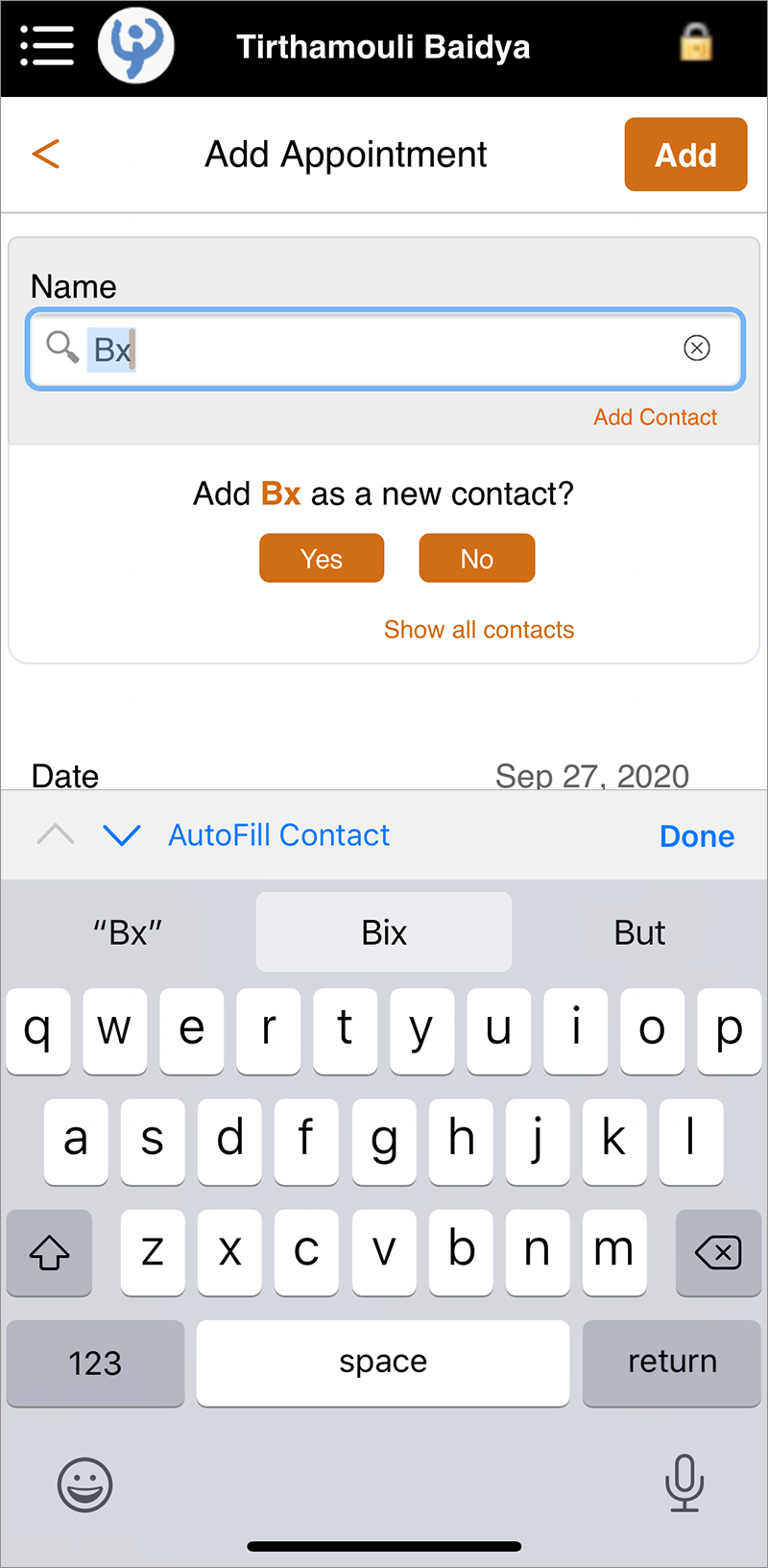
Notice that there's also a link for "Show all contacts." Perhaps you know that the "Bx" you typed isn't correct and you'd like to see a list of ALL contacts so you can scroll through and find the one you're looking for. Clicking "Show all contacts" does just that:
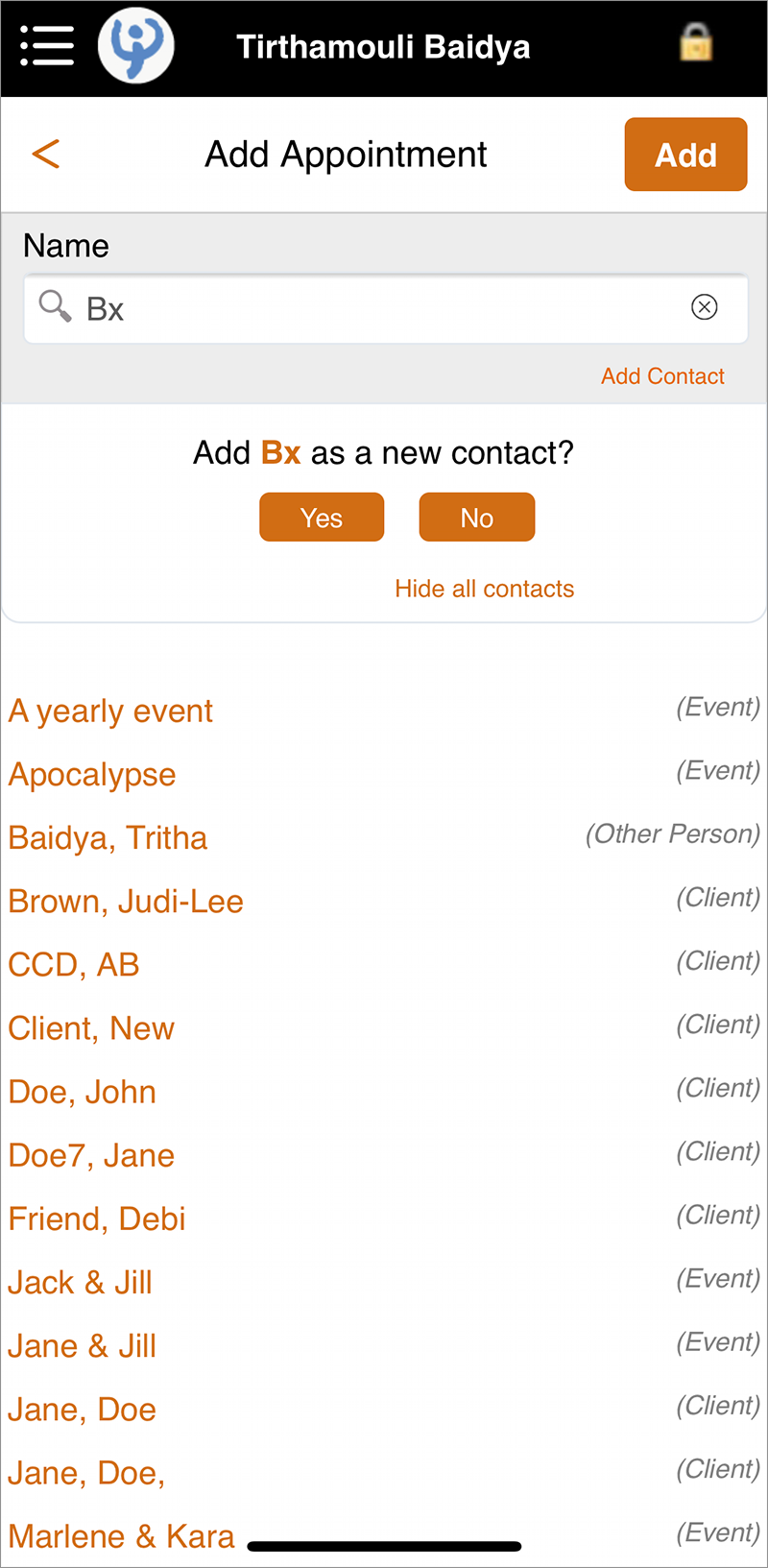
All contacts in your PSYBooks database are now presented, allowing you to scroll through them. Each has the type of contact (Client, Other Person, Event, Group, etc.) listed on the right. Notice also that the "Show all contacts" link has become "Hide all contacts" if you still don't find what you want and need to just get this list out of your way.
You also always have the option of adding a new contact. For example, in any of the screens above that said, "Add Bx as a new contact?" - if we had pressed "Yes," we would have gotten a screen like this, asking us to select the type of contact we want to enter, i.e., a client or some other type of contact like another person, event, or group:
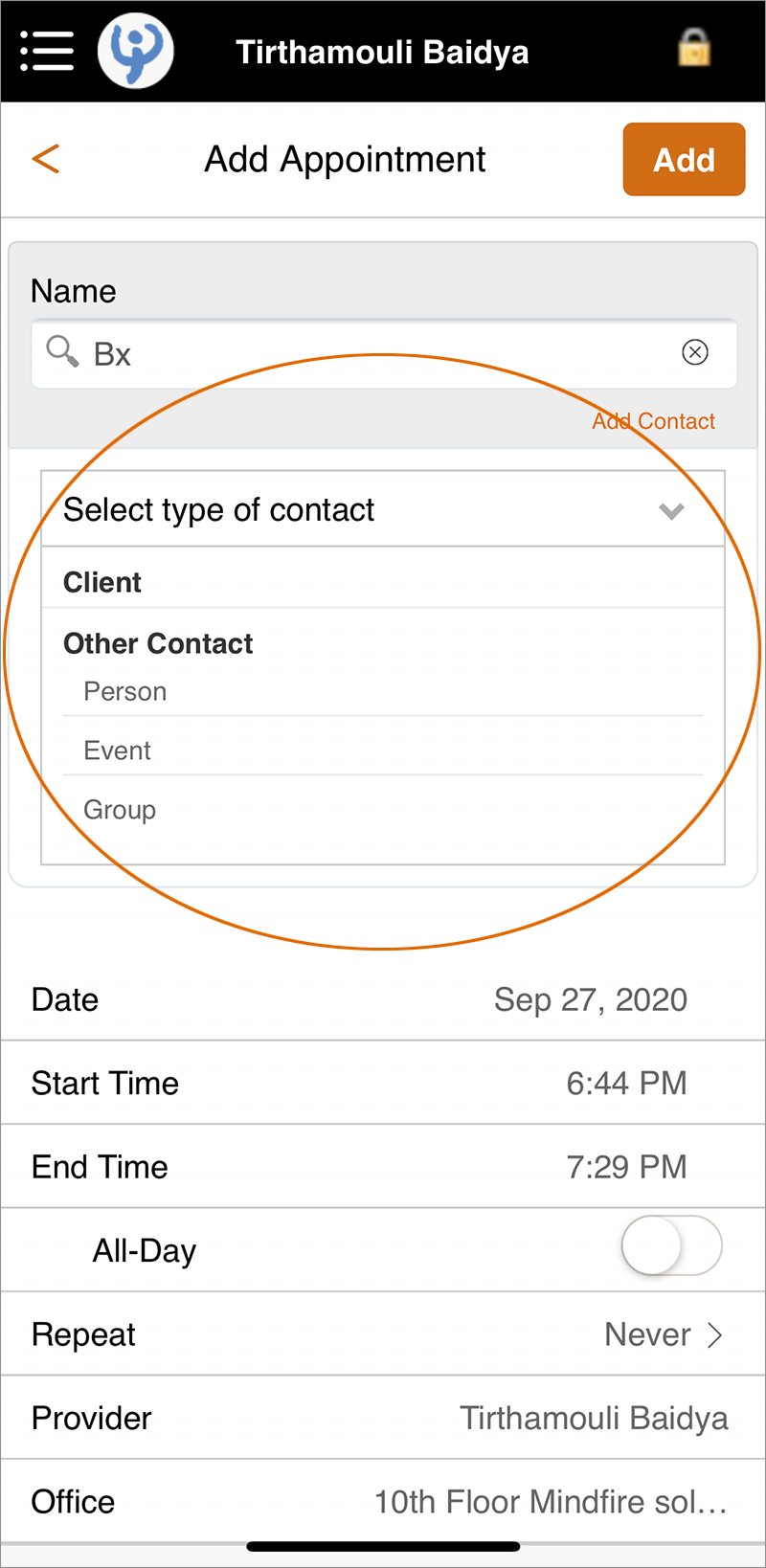
Once that selection is made, the correct form will open, allowing you to enter the new contact and then return to the Add Appointment form and finish adding your appointment as normal.
- Selected Year
Calendar
As mentioned above, when you first log in to PSYBooks Mobile, you're on one of the available views of the Calendar page. Specifically, you're on the monthly, split-screen view, which means you can see today's schedule at the bottom of the page, and the entire month at the top:
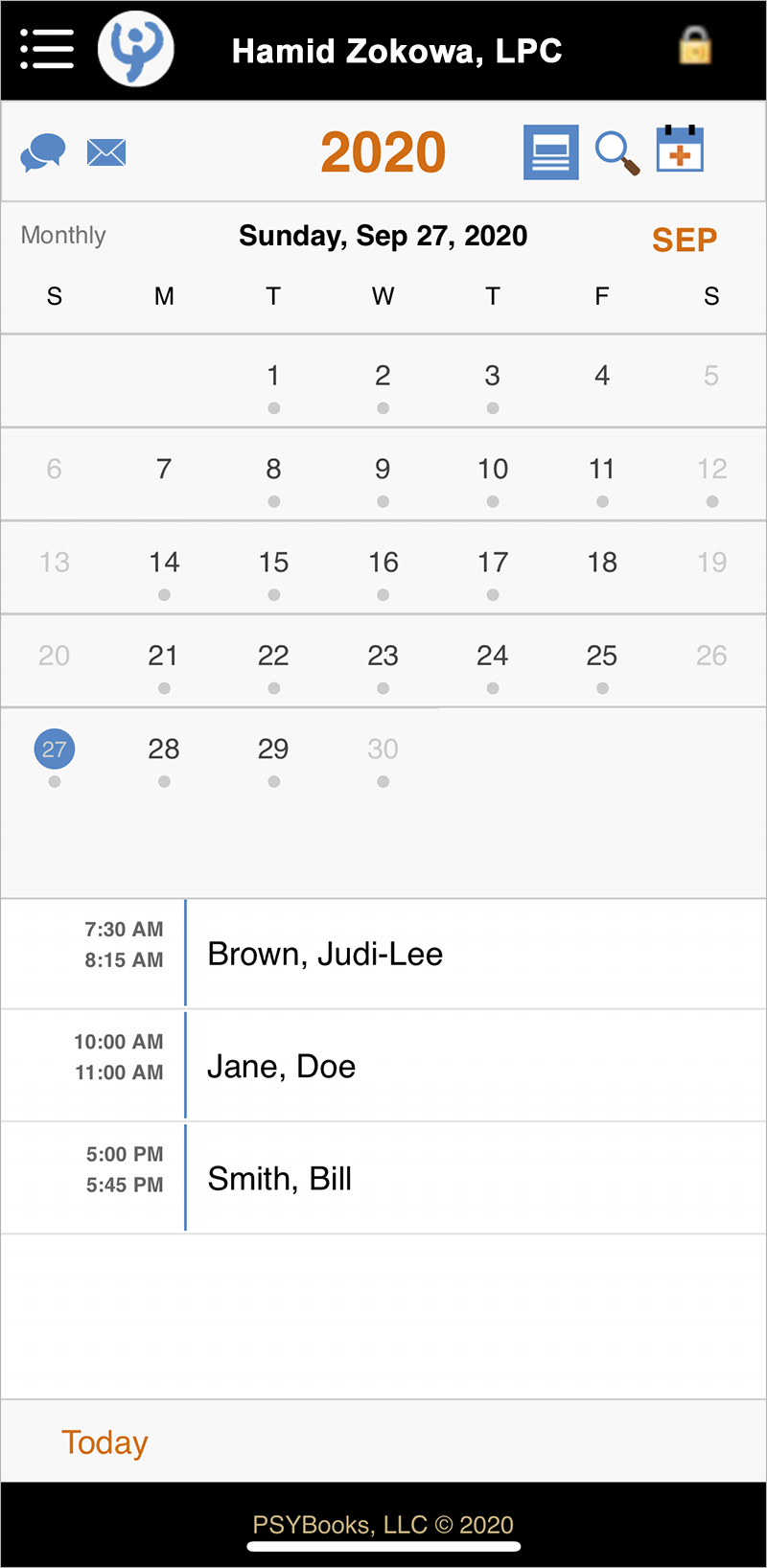
In the calendar portion of the split-screen, some dates have dots below them and others do not. Dates with dots indicate that there are appointments on that date. A date without a dot does not have any appointments:
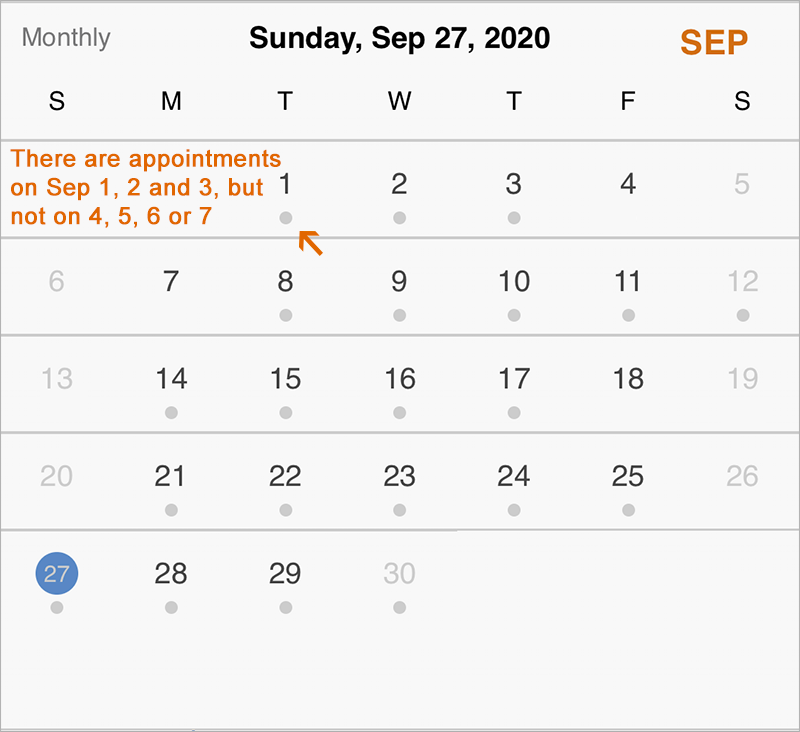
The blue circle indicates the selected date. If the selected date is also the current date, as in the screenshot above, the blue circle is the only one you'll have on your calendar. When the selected date is not the current date, the current date is indicated with an orange dot and the selected date is still blue:
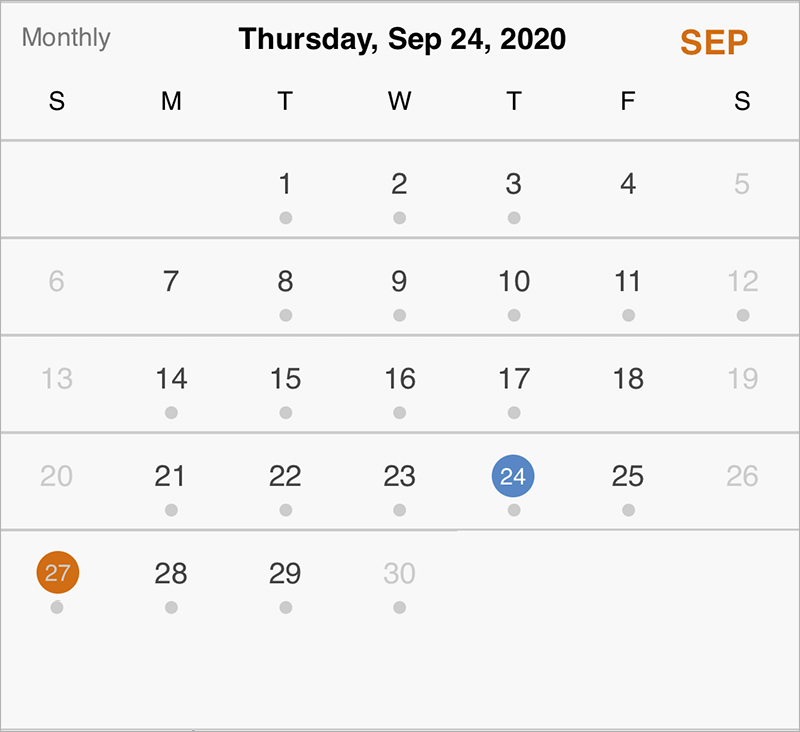
Notice that the date at the top reflects the selected date (Thursday, Sep 24, 2020) instead of the current date. If you want to see your appointments on a different date, just touch the date you need and that day's appointments will appear in the bottom half of the screen:
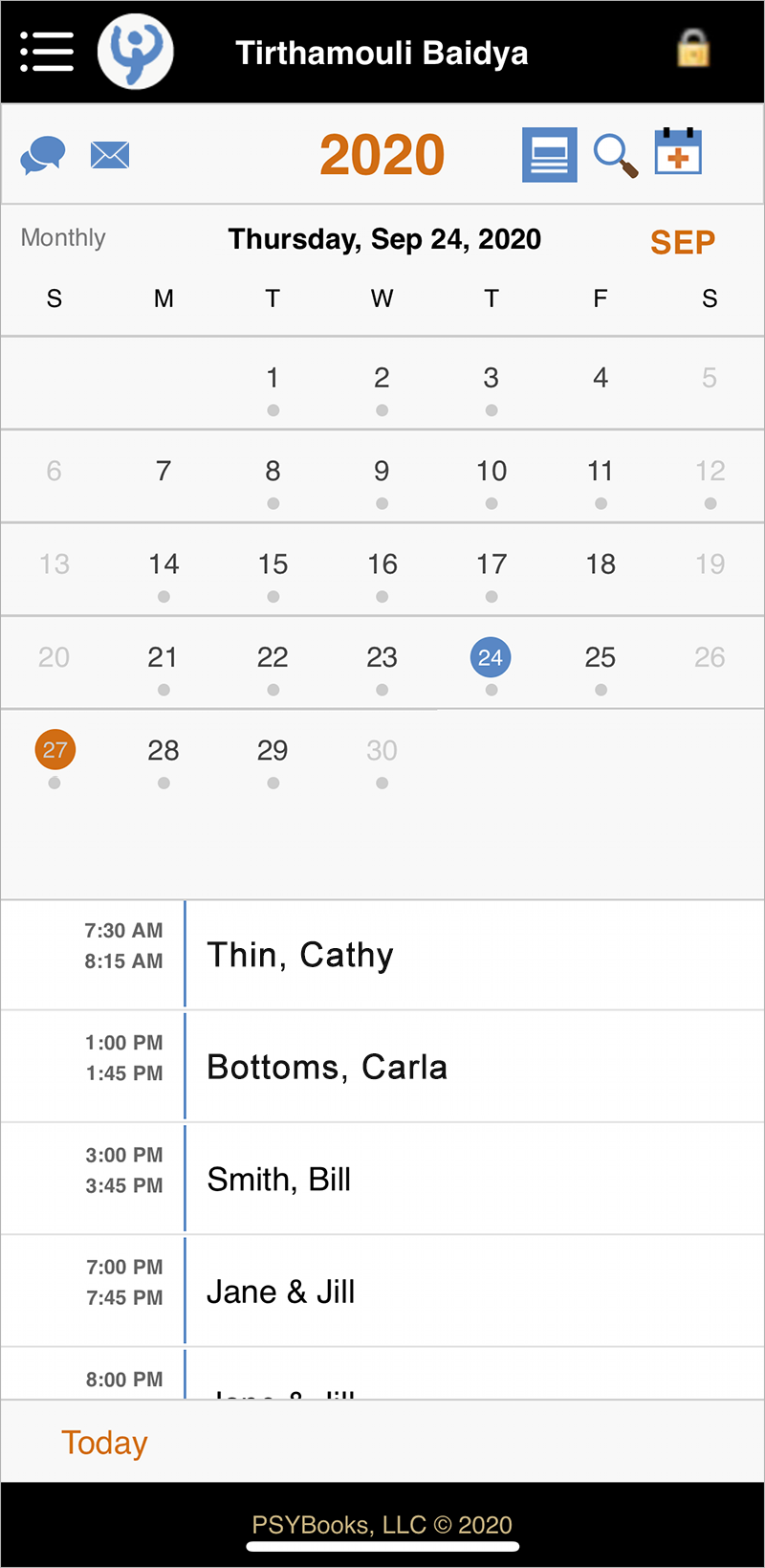
Local Tools on the Calendar Pages
As discussed in the general Global Nav section above, the last 4 items on the home page Global Nav belong to the Calendar section of the app so have already been discussed. They are: Selected Year, Split Screen Toggle, Search and Add Appointment. However, the calendar pages also have a set of local nav tools under the Global Nav:

Each of the numbered items on the Calendar local nav shown above will be discussed separately:
- Status Indicator

This status indicator is just another way to remind you whether you're in the Monthly or Weekly calendar view. It works in direction conjunction with the Split Screen Toggle tool that was discussed above:
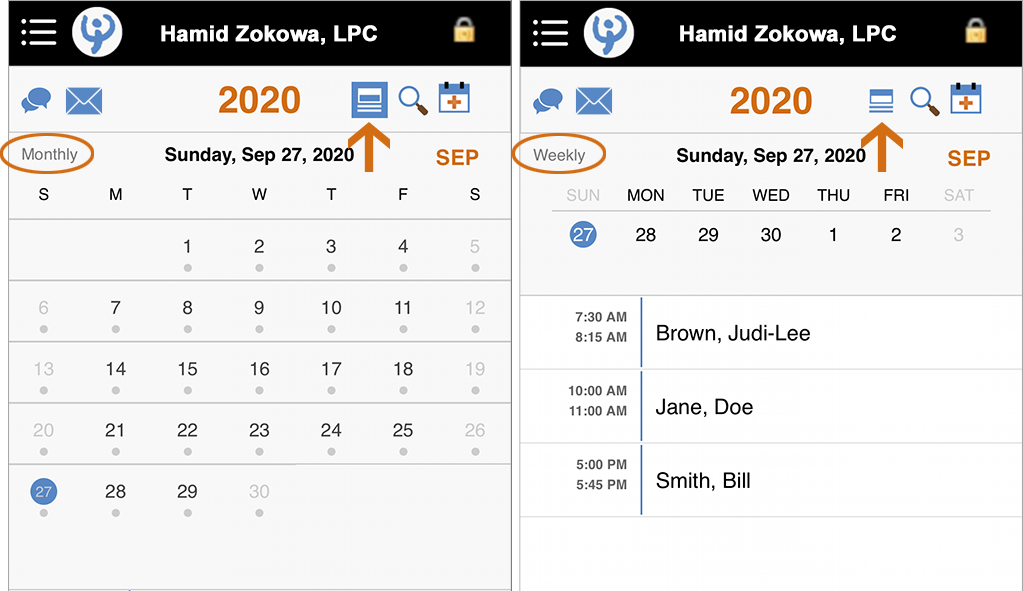
- Selected Date

This shows you the date you're currently viewing. As discussed above, this may or may not also be today's date.
- Switch to Monthly View

Again, since the text for this last local nav tool is orange, it's a link. If you press it, you dismiss the split screen mode and go into a monthly view that allows you to scroll through months until you find the one you need. Monthly View looks like this:
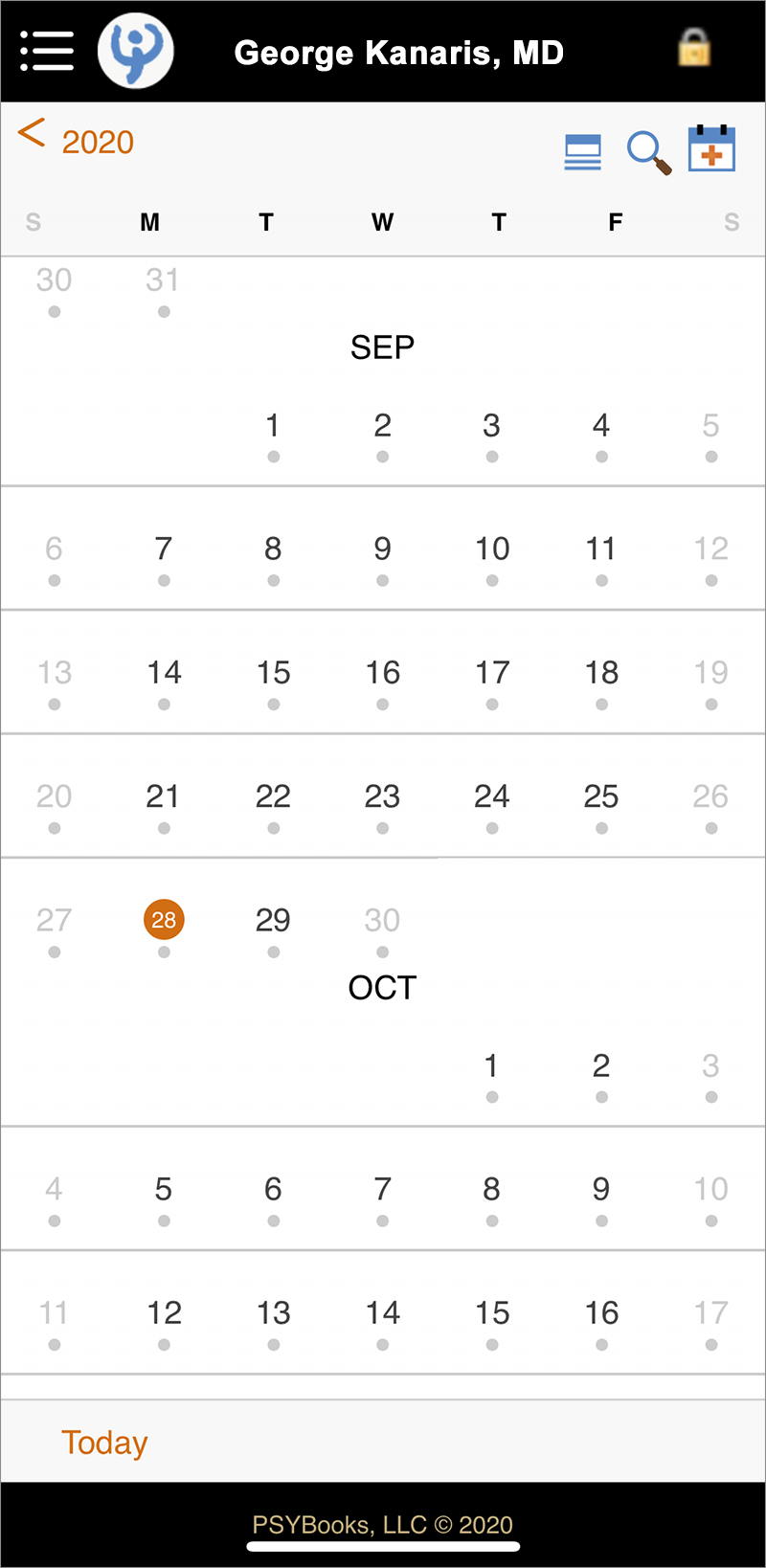
If you press the back arrow or the year link at the top left, it will take you to the Yearly View:

You can swipe left and right to change years. Clicking a specific date on the yearly view takes you back to the monthly view. Swiping up and down in the monthly view will allow you to scroll months in that year. Clicking a date on Monthly View goes to a split-screen view with that date's appointments.
View/Edit Appointment
You can enter the Edit Appointment mode from the View Appointment screen. You can open View Appointment by pressing any appointment in a split-screen mode or by pressing an appointment found using search:
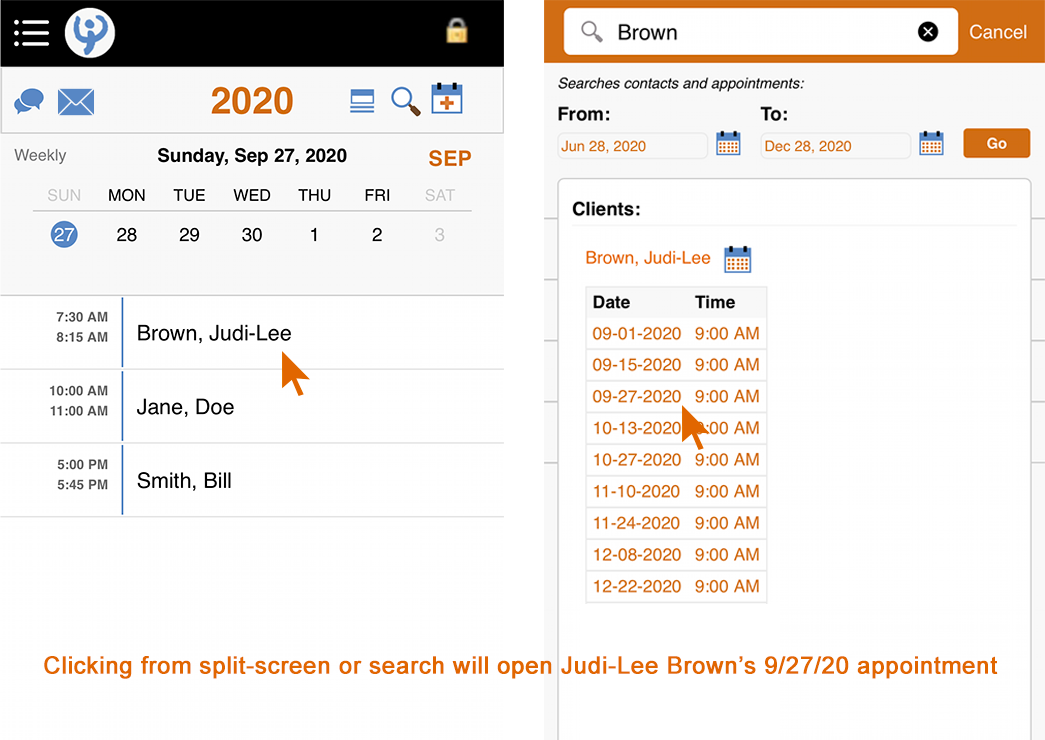
Once you've opened the appointment, you're in the View Appointment mode and the screen changes to this:
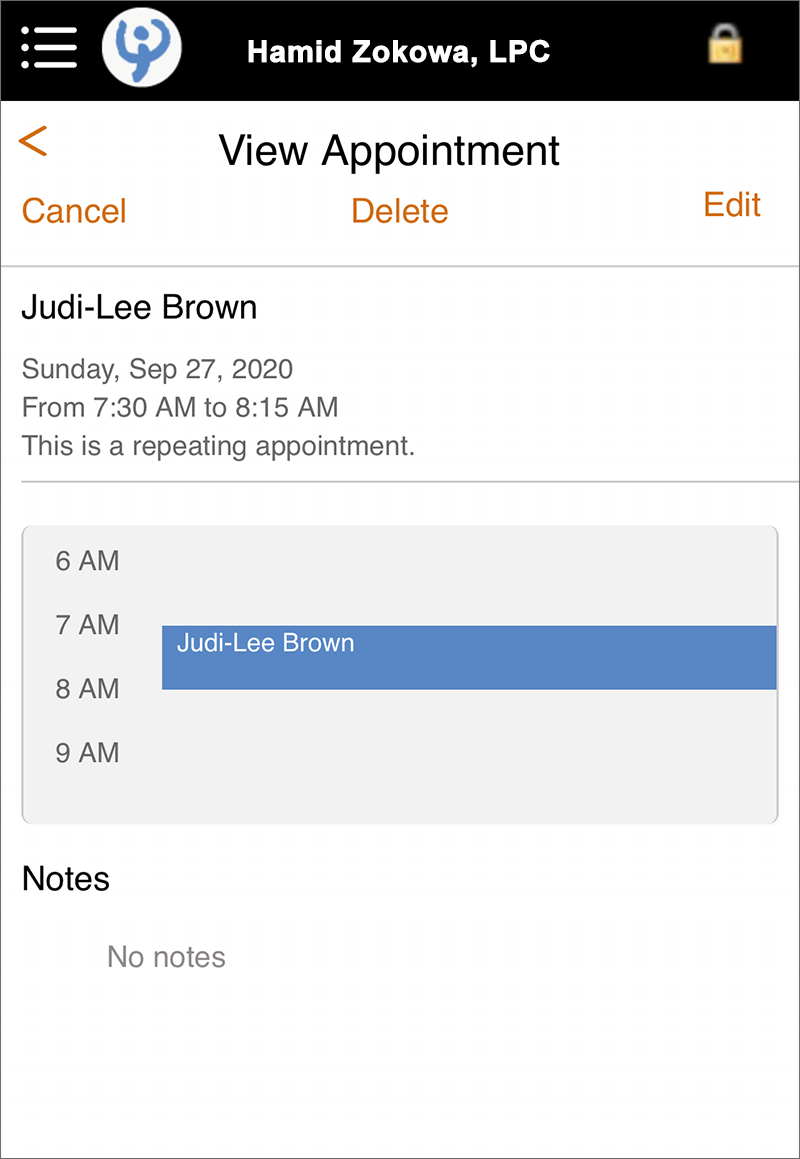
Looking at the organge links at the top, you can see that from this screen, you can Cancel, Delete or Edit the appointment. You can also see important information about the appointment, such as any notes you may have written and also whether it's a repeating appointment.
Start Video Session
When you're signed up for PSYBooks Video, you can start your sessions from your phone using PSYBooks Mobile. The first step is to enter the View Appointment mode, such as was described above. When the appointment mode is Video, the View Appointment screen has a button which allows you to start the PSYBooks video session right from this page:
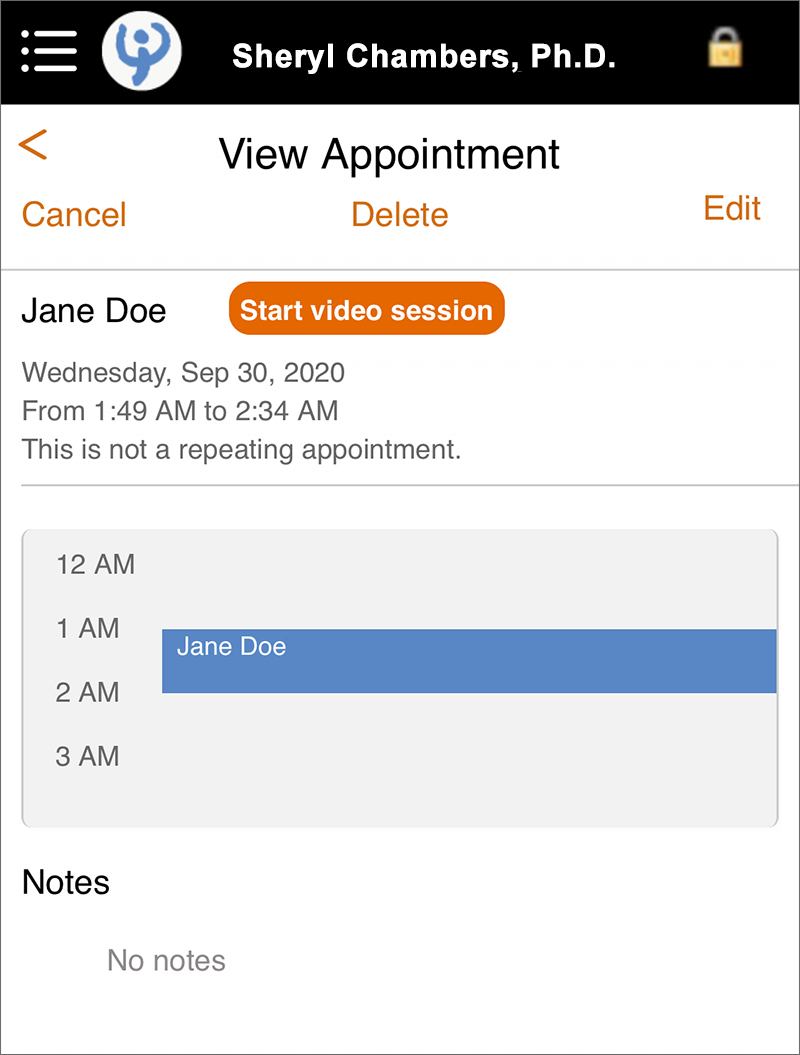
As you know, phone operating systems, versions and browsers are all different, so it's impossible to tell exactly what screens you and your patients will encounter the first time you try to conduct a video session via your mobile devices. However, the following section may give you some helpful problem-solving tips if you have difficulty:
- What Should Happen
When you click the "Start video session" button on the screen above, you should be taken to the same Secure Video page you're used to seeing in the regular PSYBooks app:
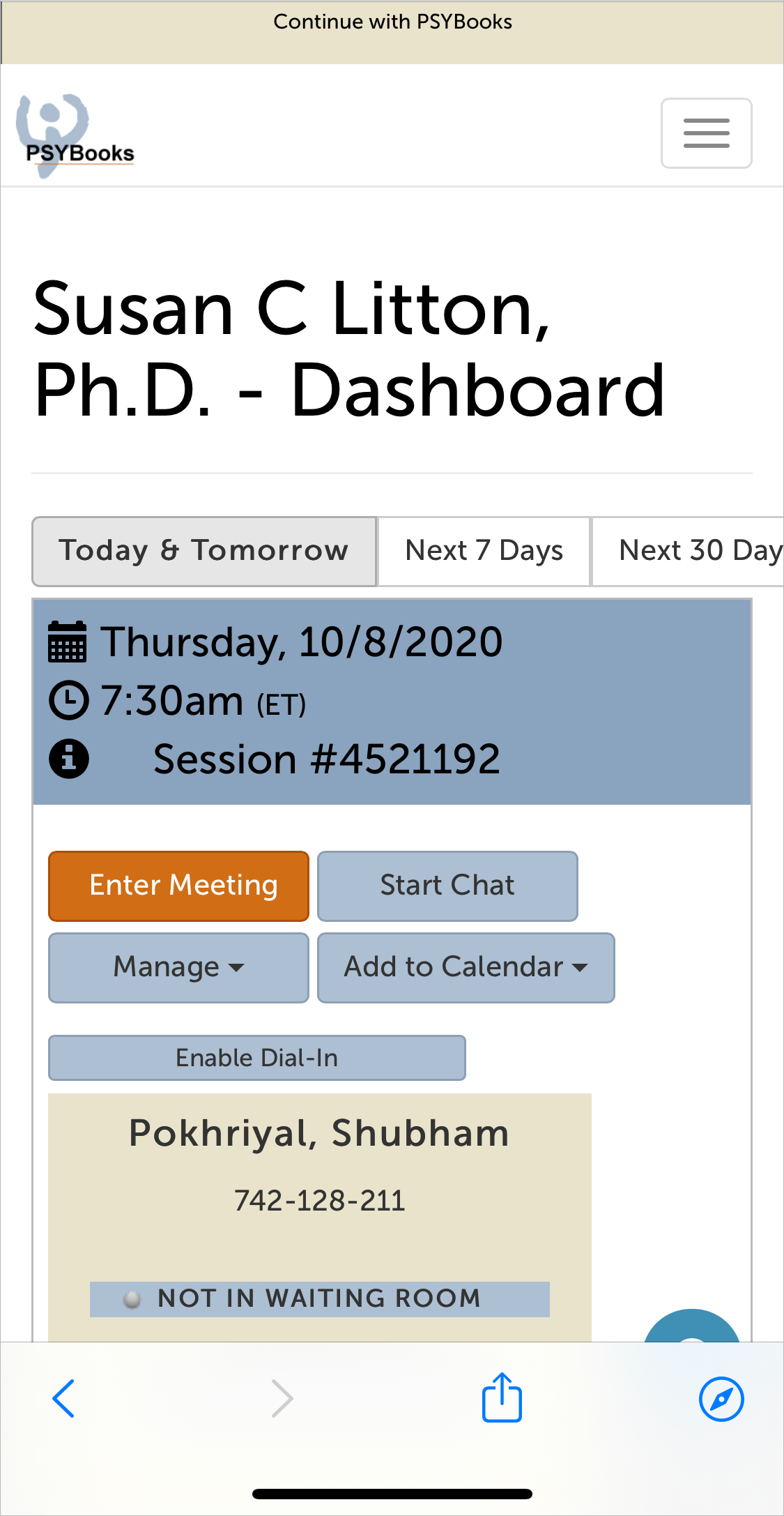
From here, you'd just click the orange "Enter Meeting" button like you normally would and be in the video room. However, the first time you or your clients try accessing video sessions on the Mobile app, there may be some kinks to iron out. Hopefully the next section will help you troubleshoot, should things not go as expected.
- Popup Blockers
If you click the "Start video session" button and nothing happens, it's more than likely because the browser you're using has a popup blocker enabled by default. You should get an error message at the bottom of the screen when this is what's causing the problem:
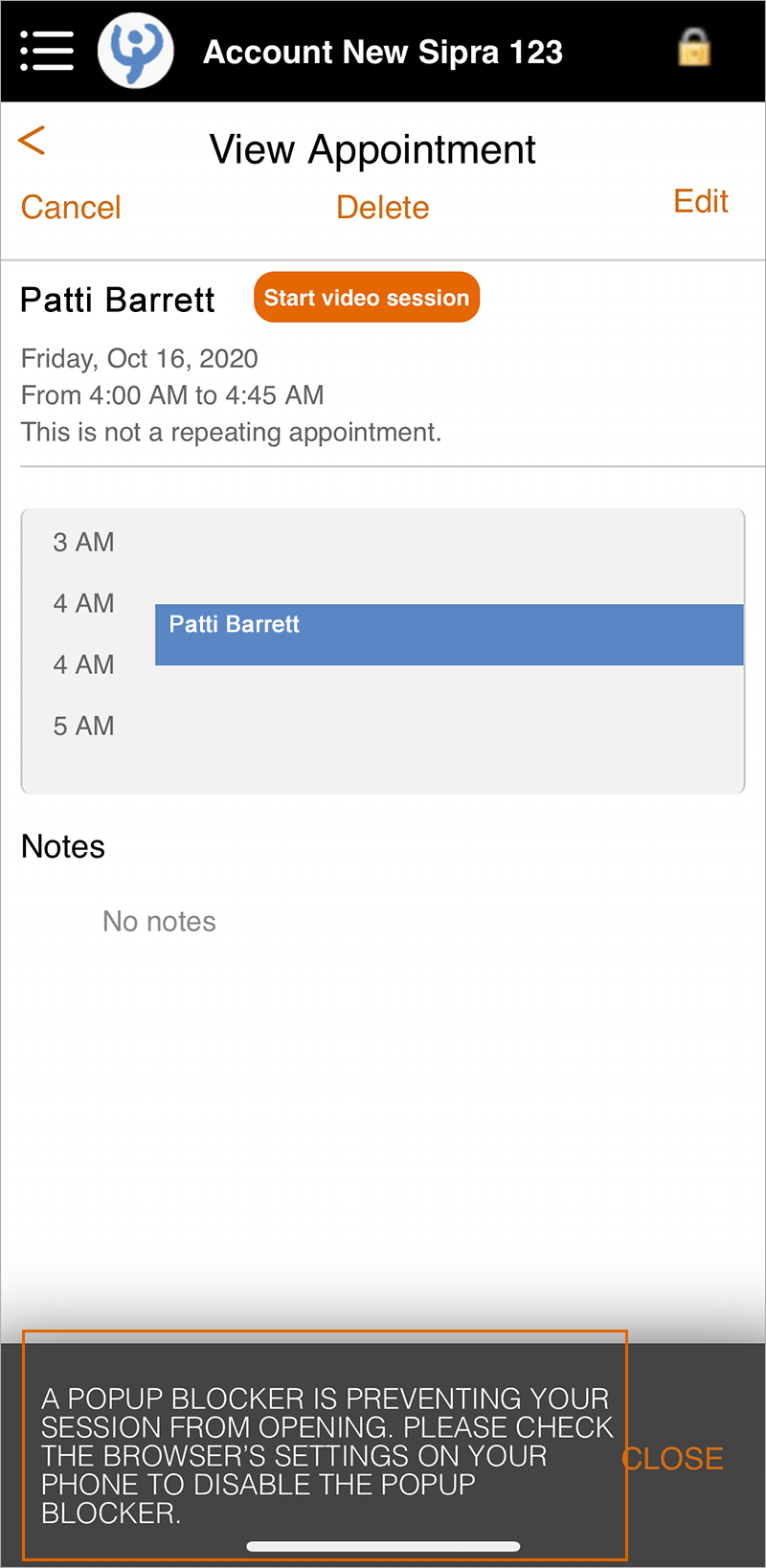
Some mobile browsers block popups by default. The screenshot below - taken from an iPhone X - was found by going to Settings > Safari. As you can see, Safari had the popup blocker set to on:
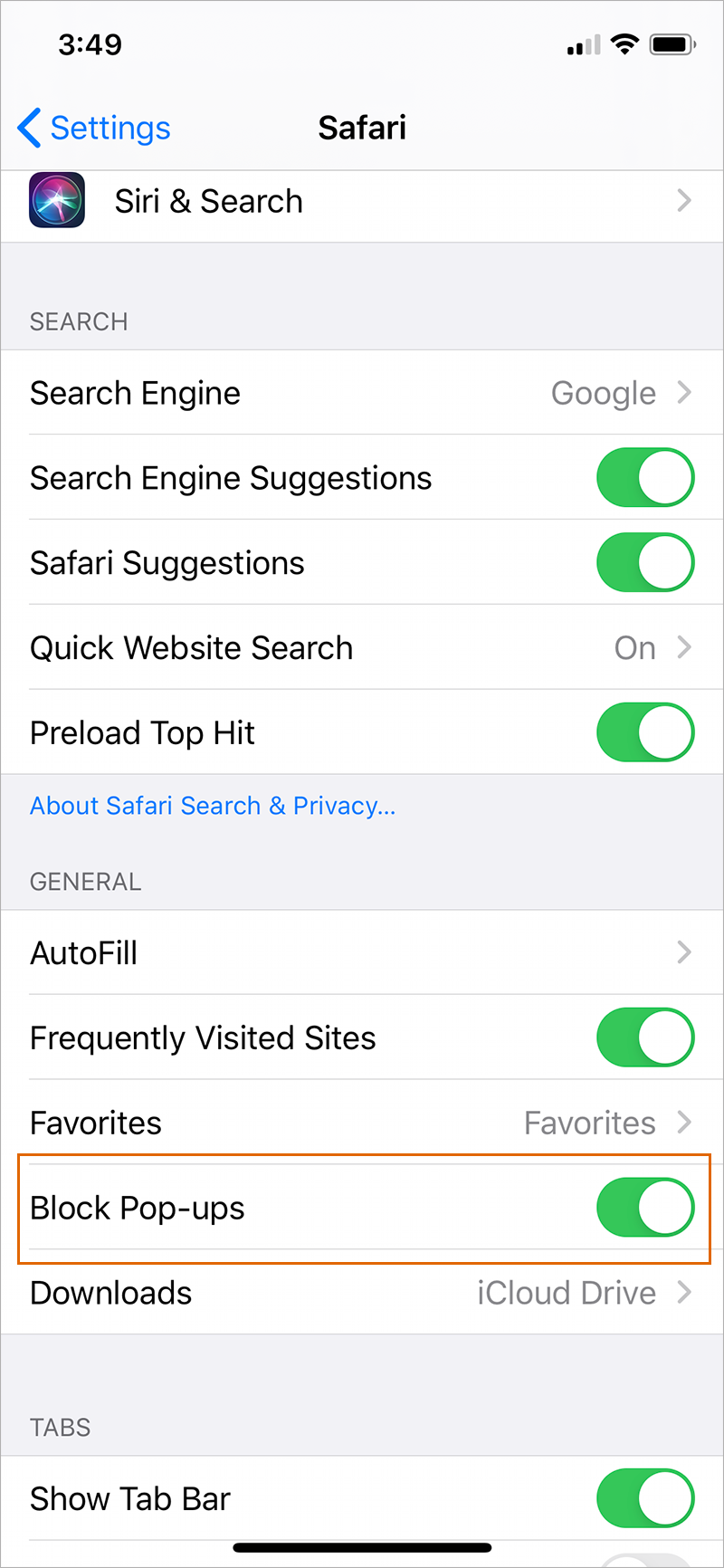
This can easily be fixed by sliding the button to the "off" position. After you've done that, you should be able to go back to the View Appointment window in PSYBooks Mobile and start the video session. If you're not sure how to check the popup blocker settings in the browser you're using on your phone, try Googling it, including the name of the browser you're using, plus your phone type and version, for example: Chrome popup blocker Android 10.
- Safe Driving Mode
Another screen you might get is something similar to the one below:
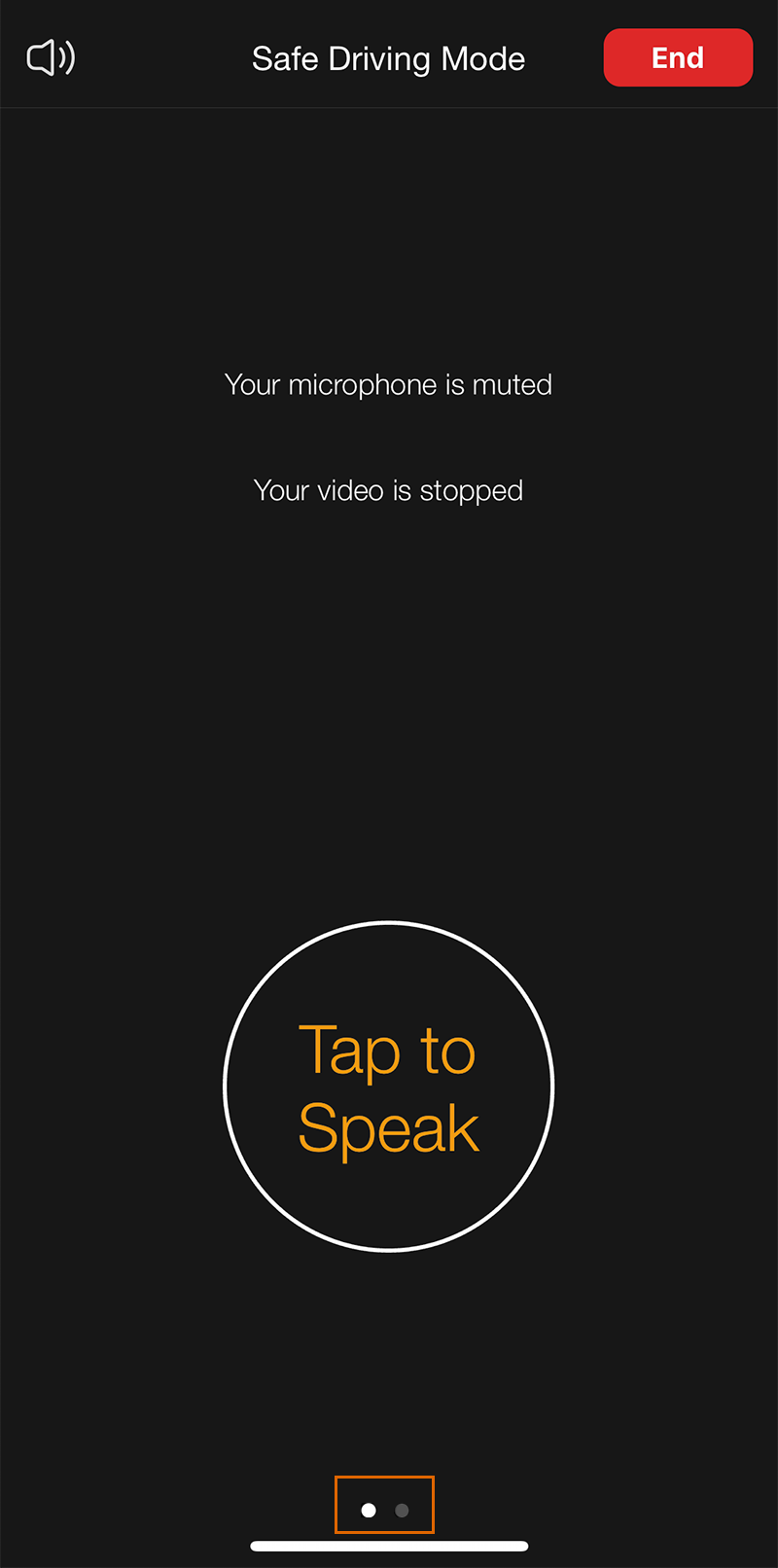
In this situation, the phone has detected a motion to make it think you might be driving, so even though Zoom has opened and you're IN the chat (you can tell by the speaker icon on the left and the red "End" button on the right), it's in Safe Driving Mode, i.e., you can't see yourself or your client and your microphone is muted. Notice the two dots at the very bottom (outlined in orange). When you see dots at the bottom of a phone screen, it indicates that you should be able to swipe left or right and see other screens. In the situation above, swiping left produced this screen:
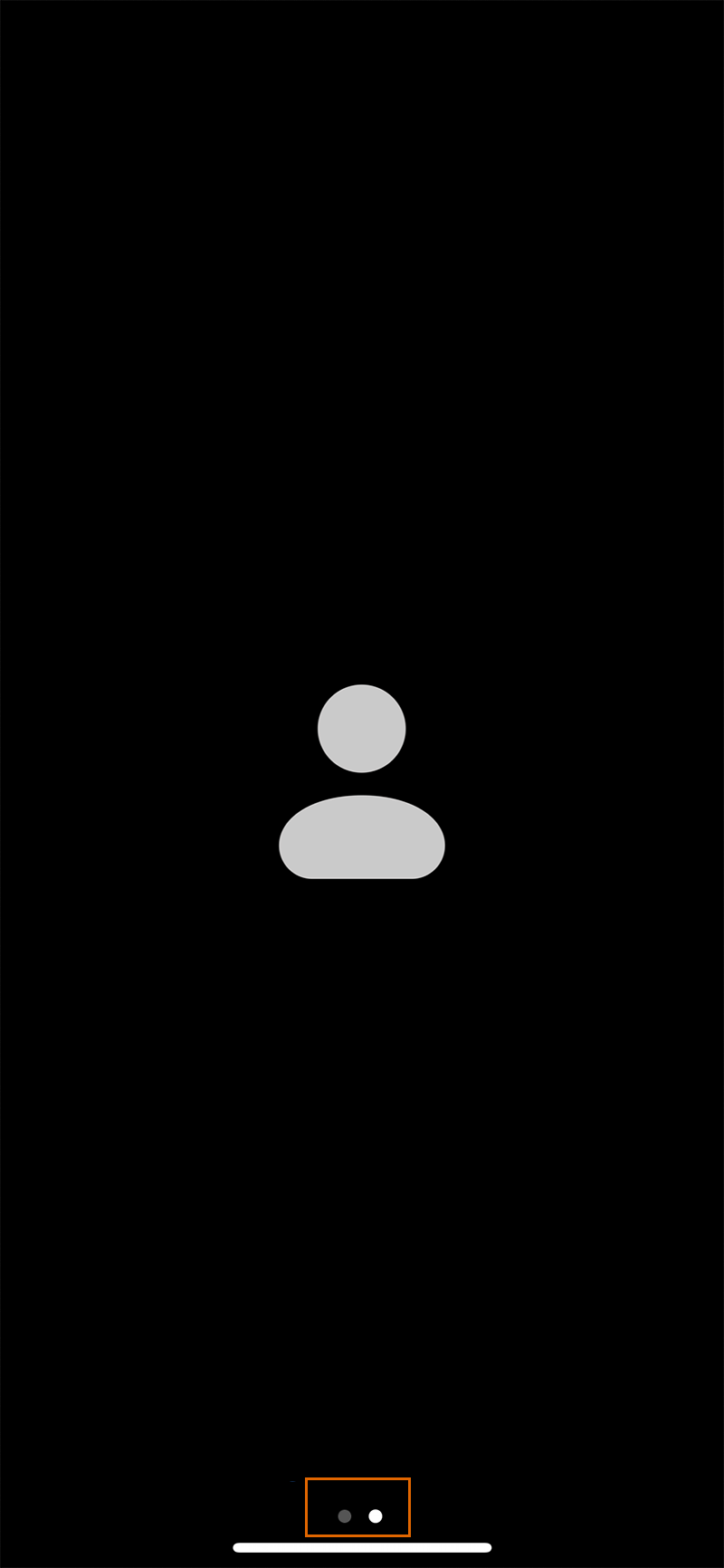
This still isn't the screen we want, however, if you click anywhere on this screen, it should open to the regular video layout you're accustomed to where you can see both yourself and your patient and be able to conduct your session.
Contacts
The other main area in PSYBooks Mobile is Contacts. When you first press "Contacts" from the Hamburger Menu in the Status Bar, you'll get a page that looks like this:
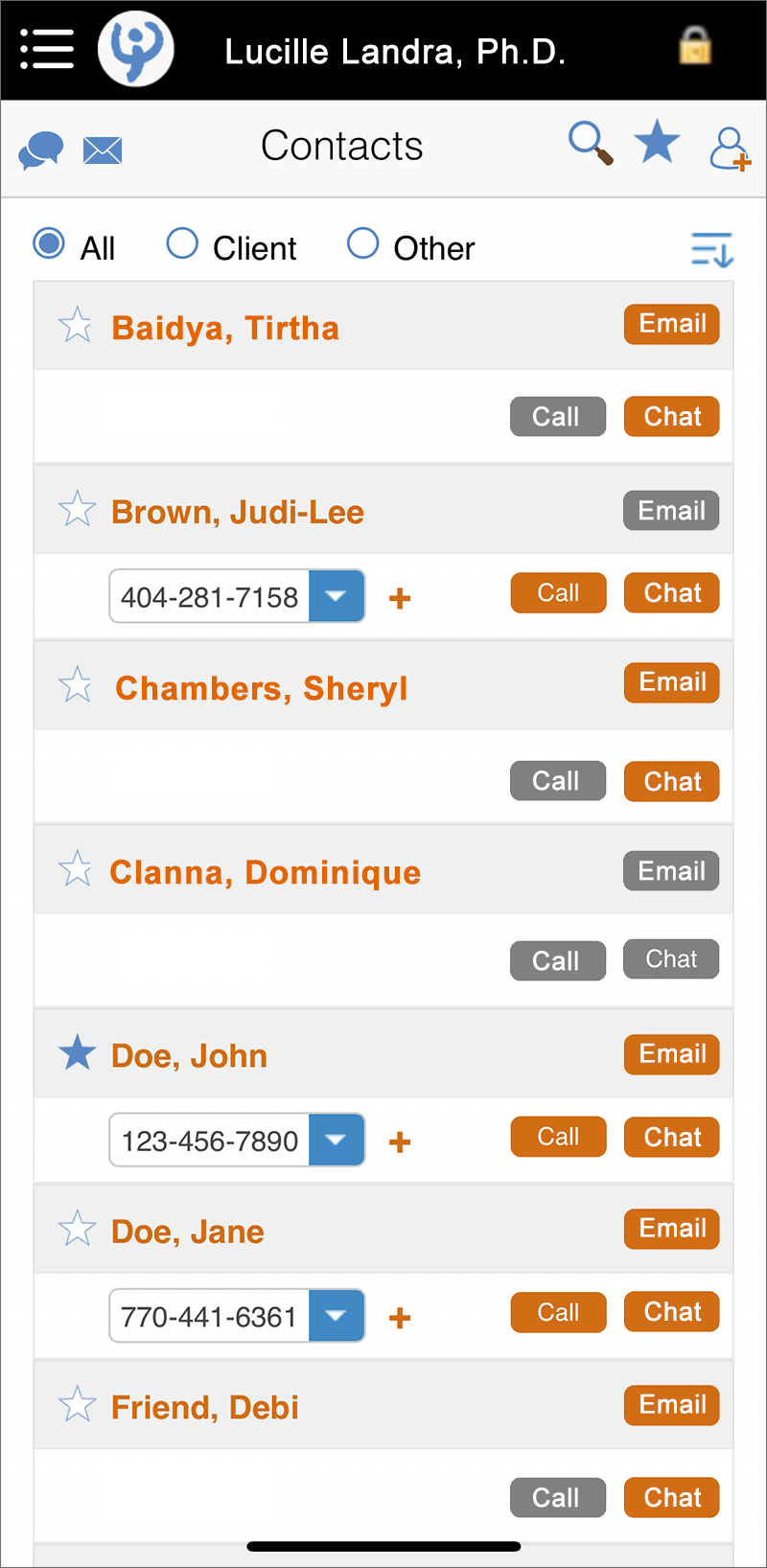
Global Tools on the Contacts Pages
Although the Status Bar on the screenshot above is the same as we saw in the Calendar section of PSYBooks Mobile, some of the tools on the global nav have been changed to include tools that more closely pertain to working with contacts. It looks like this:

Each of the numbered items above will be discussed separately below:
- Search

The Search tool in the Contacts area is also the same tool we saw in the Calendar global nav, i.e., it searches both Contacts and appointments on your Calendar.
- Favorites

The Favorites tool in the global nav allows you to view only those contacts whom you've previously marked as a Favorite. (We'll discuss how to add a Favorite below.) Using the global nav Favorites tool will allow you to quickly bring up those contacts with whom you communicate most often.
- Add Contact

The Add Contact tool allows you to add contacts on the go - you're not tied to the device you use at the office. When you press the Add Contact tool, it changes to it's selected state (blue background) and opens the second row of the global nav:

Notice that, just like in the regular PSYBooks app, you're able to choose a contact type - either a Client, a "Person" (i.e., someone other than a client), an Event or even a Group (including both video and non-video groups). Once you make your choice with the radio buttons, the correct form will open.
Remember that if you need to add a contact, you have to press the Add Contact tool FIRST. It can be easy to see the "All Client Other" radio buttons on the global nav and think that's what you press to add that type of contact. However, those radio buttons have a totally different function, which we'll discuss next.
- Type of Contact

The "All Client Other" global nav radio buttons filter what list you see in the screen below. They have nothing to do with adding clients, but rather allow you to sort your existing contacts to only see the group you need. The mockup below shows what an "All" radio button might produce, vs the Client radio button. As you would expect, all clients appear in "All" but not all "All" contacts are clients:
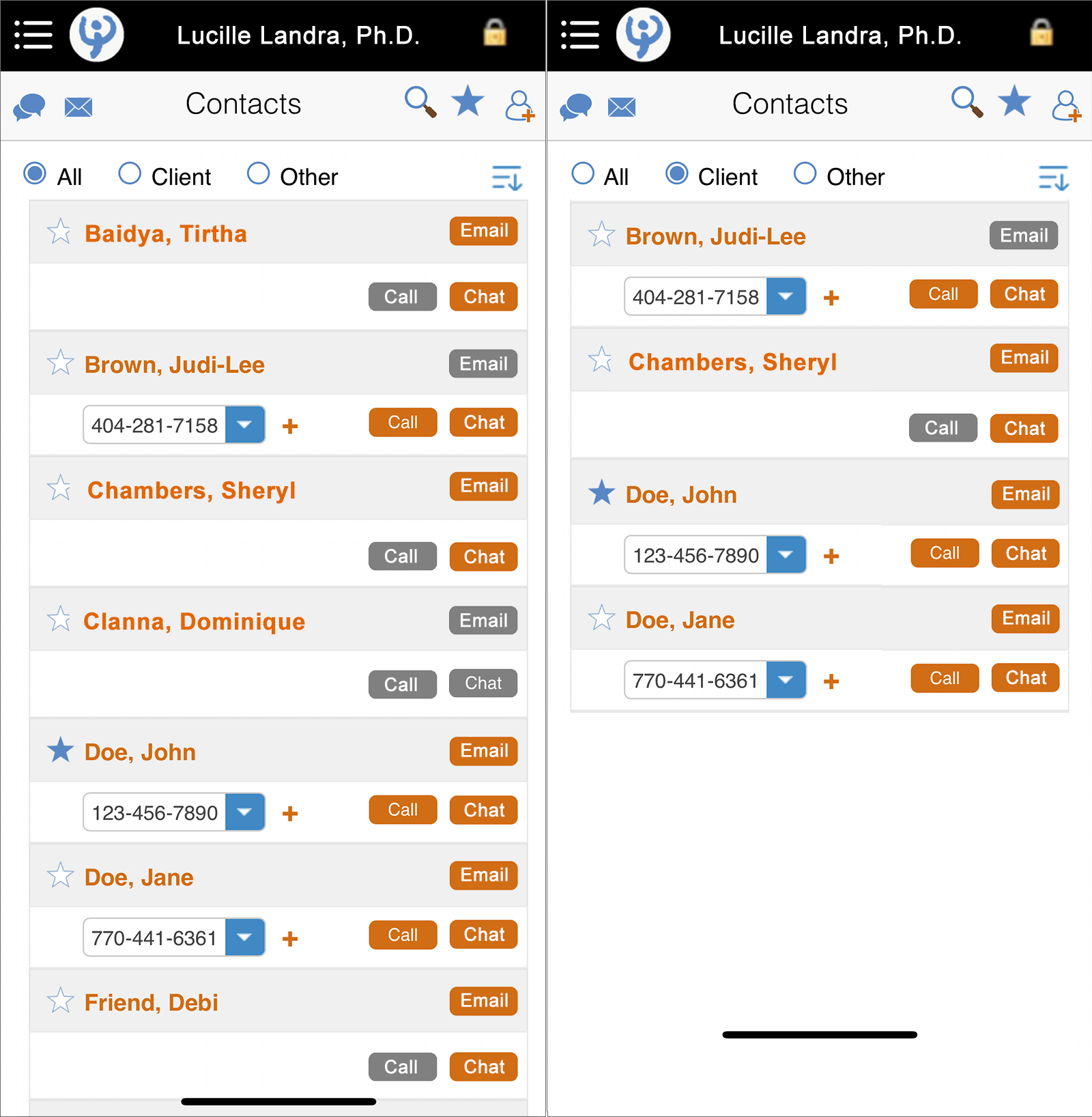
If you select the "Other" radio button from the global nav, you get another dropdown area that allows you to refine your choice:
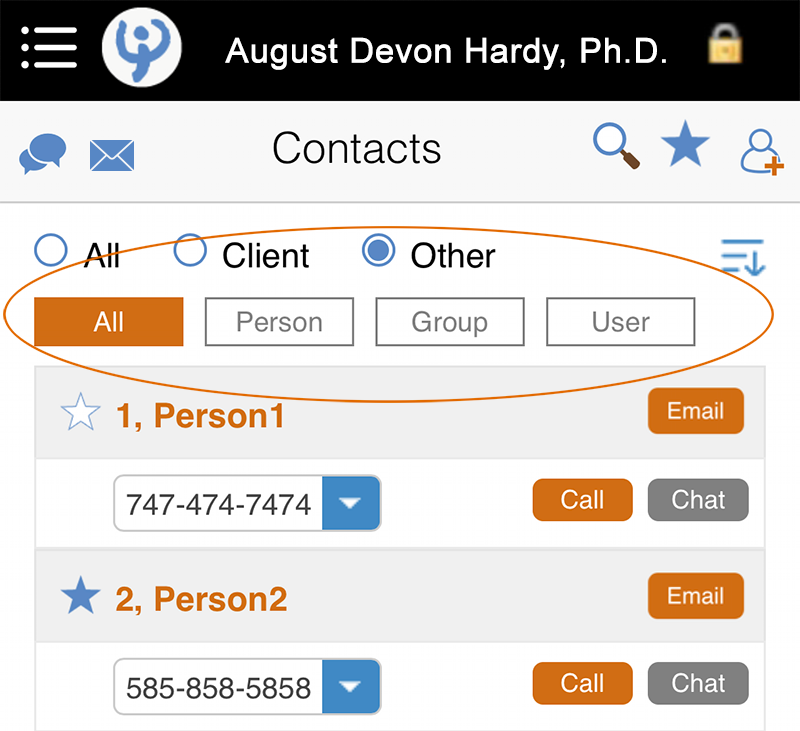
Again, these are "view" filters that determine what you see on your screen. For example, if you selected "Group" you'd see all Groups you've added in PSYBooks.
Notice that the Event contact type is not listed. That's because Events don't have email addresses or phones. Since there's no way to contact an Event, there's no need to display them on a Contacts page. If you need to create an event that you CAN contact, make it a Person contact type instead.
However, there IS a filter for Users, which will allow you to easily bring up the list of Users you've added to PSYBooks. You can't add a User from mobile. Users and also Subscribers have to be added from the regular PSYBooks app. This is because they are more complex since you need to assign their permissions. However, you can view them here and use Mobile to communicate with them.
- Sort

This final global nav tool is a toggle that allows you to change the sort of the items you're viewing from A-Z (default) to Z-A (clicked).
Contacts Functionality
Now that we've discussed the global nav of the Contacts area, let's look at what you can actually DO in Contacts. Basically, the Contacts area of your PSYBooks Mobile app is designed to be a quick, easy and HIPAA-compliant way for you to contact anyone entered in your regular PSYBooks app. Ever gotten stuck in traffic and realized you're going to be late for an appointment? It's times like that that these tools can help. The Contacts pages on Mobile allow you to call, chat or email with your clients or anyone else in your PSYBooks Contacts list. Let's see how it works:
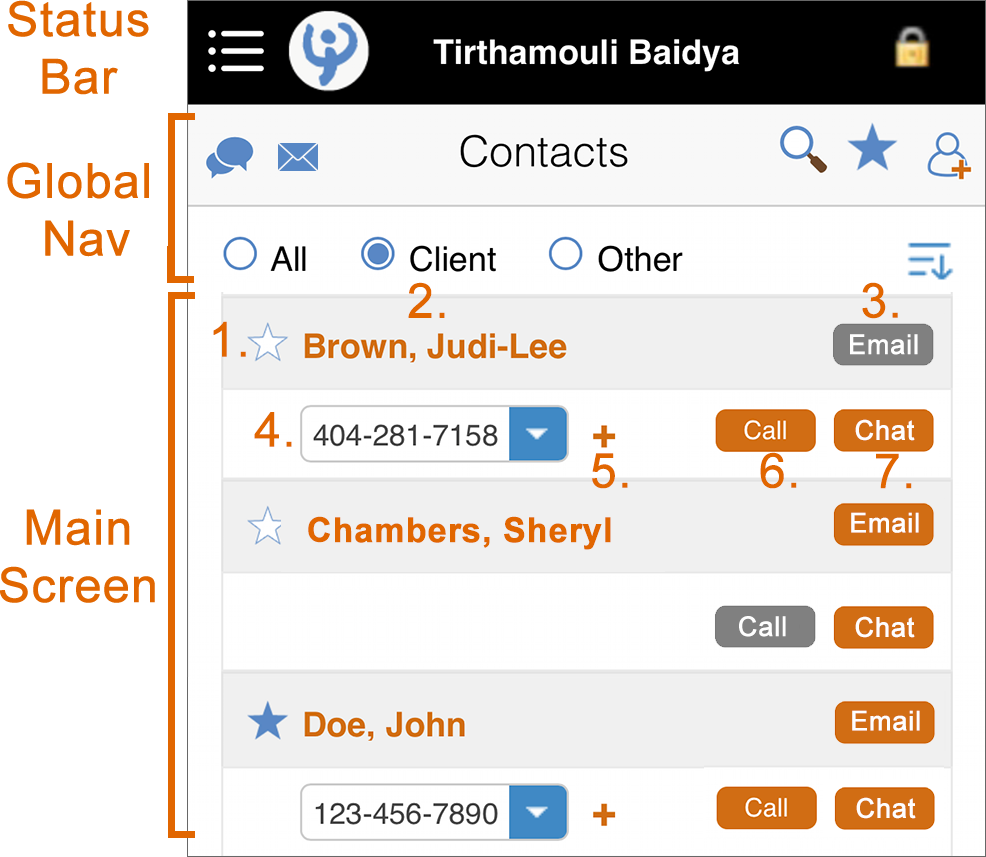
- Mark/Unmark Favorite
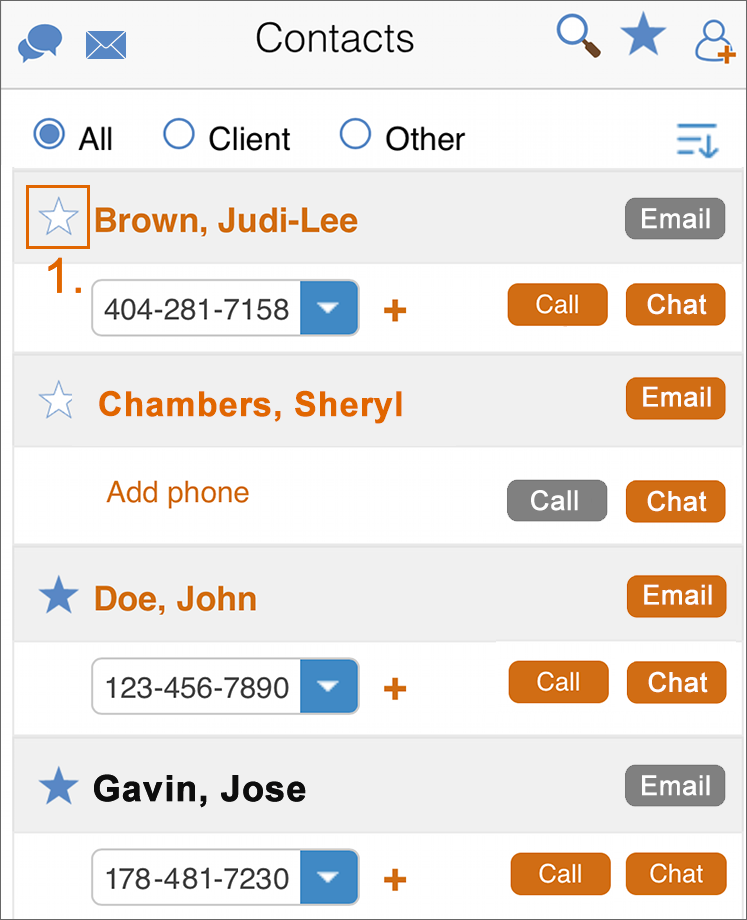
The star in front of each contact's name is how you mark the contact as a Favorite. In the screenshot above, we can tell that Judi-Lee Brown has NOT been marked as a Favorite because her star is just an outline. But if you look farther down, John Doe and also Jose Gavin's names HAVE been marked as Favorites. That means that if you touch the Favorites tool in the Contacts Global Nav, John Doe's name would appear. These are toggle tools, which means if you touch the star of an item that's already Favorited, the Favorite status will be removed. Conversely, if you touch the star of an non-Favorited item, it will mark it as a Favorite.
- Edit Contact
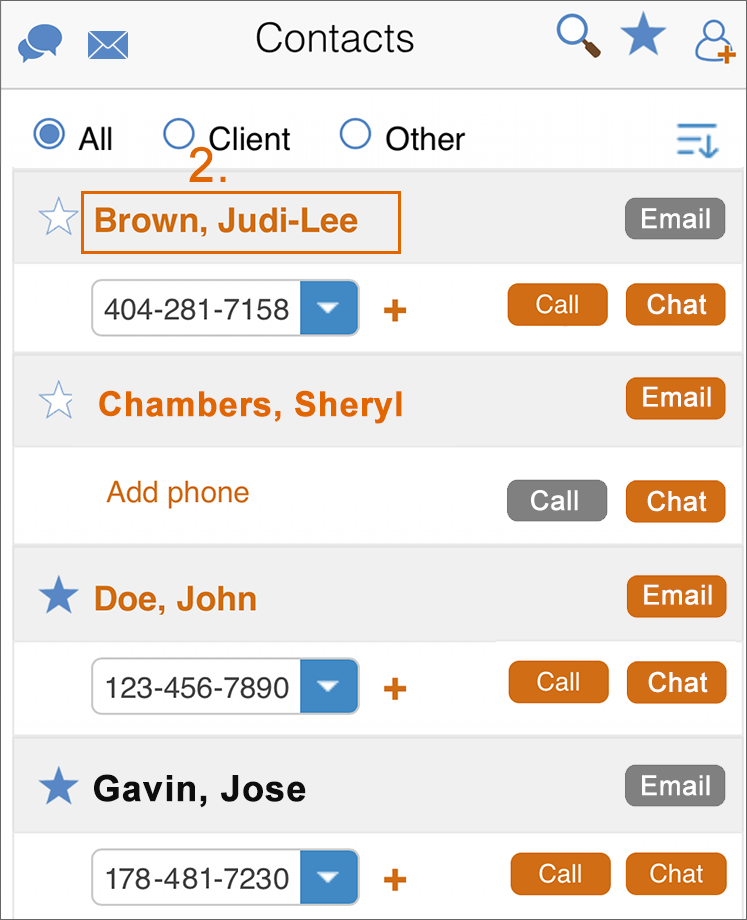
When the contact's name is in orange, it means that it's a link. Clicking it will open the edit form for that particular kind of contact (Client, Person, Group). Notice, however, that Users can NOT be edited in PSYBooks Mobile. They have to be added and edited from the regular app. Similarly, if you have other PSYBooks Subscribers in your office, you would (in most cases) not be able to edit their information. So from looking at this list, we can assume that Jose Gavin is eotjer a User or another Subscriber, not a Client or a Person type of contact, since his name is not a link.
- Email
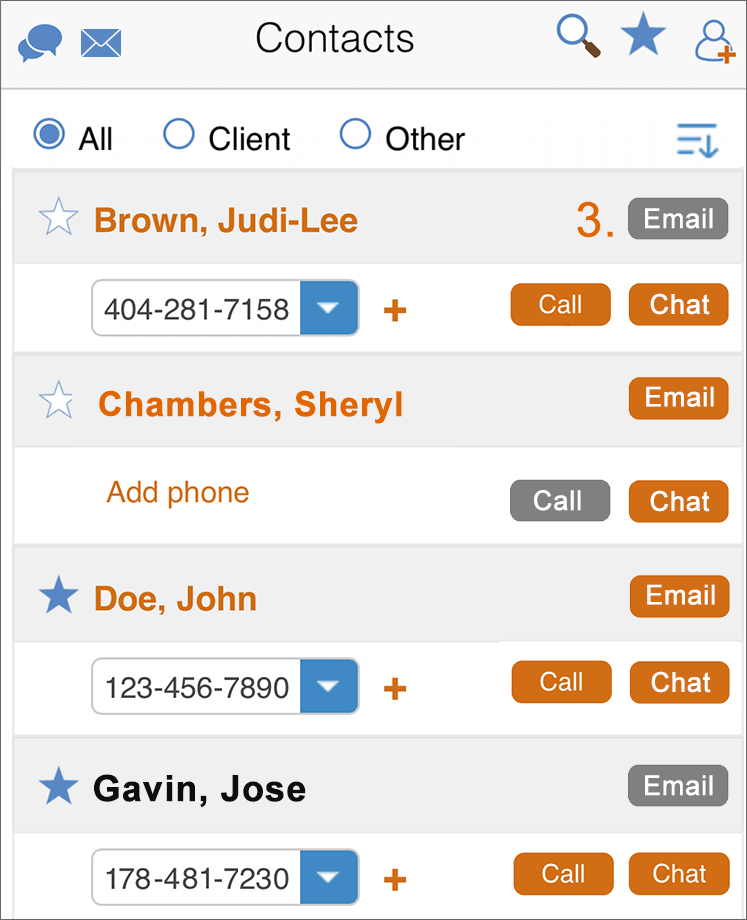
The main discussion of the Email Tools was in the Global Nav section above. You can access email in one of two ways:
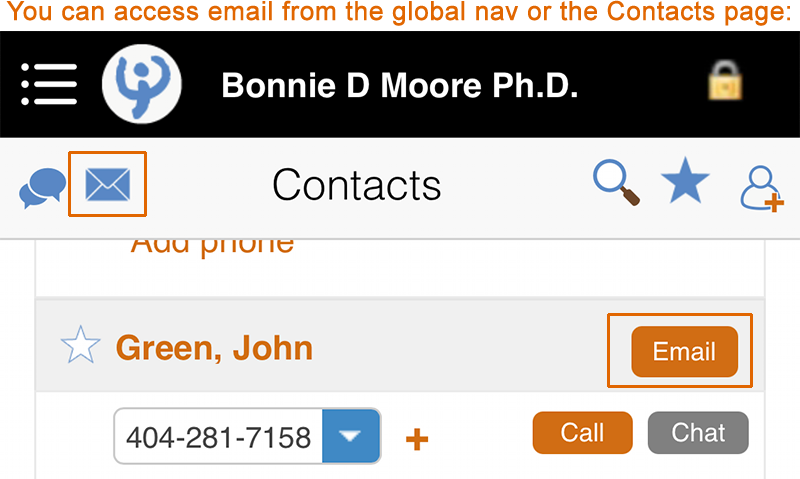
When you access email via the Contacts page, it will already have the person's email address in the To box. If the email button is gray, it means that you don't have an email address in that person's file. However, you can click the gray email button and have an easy way to add it:
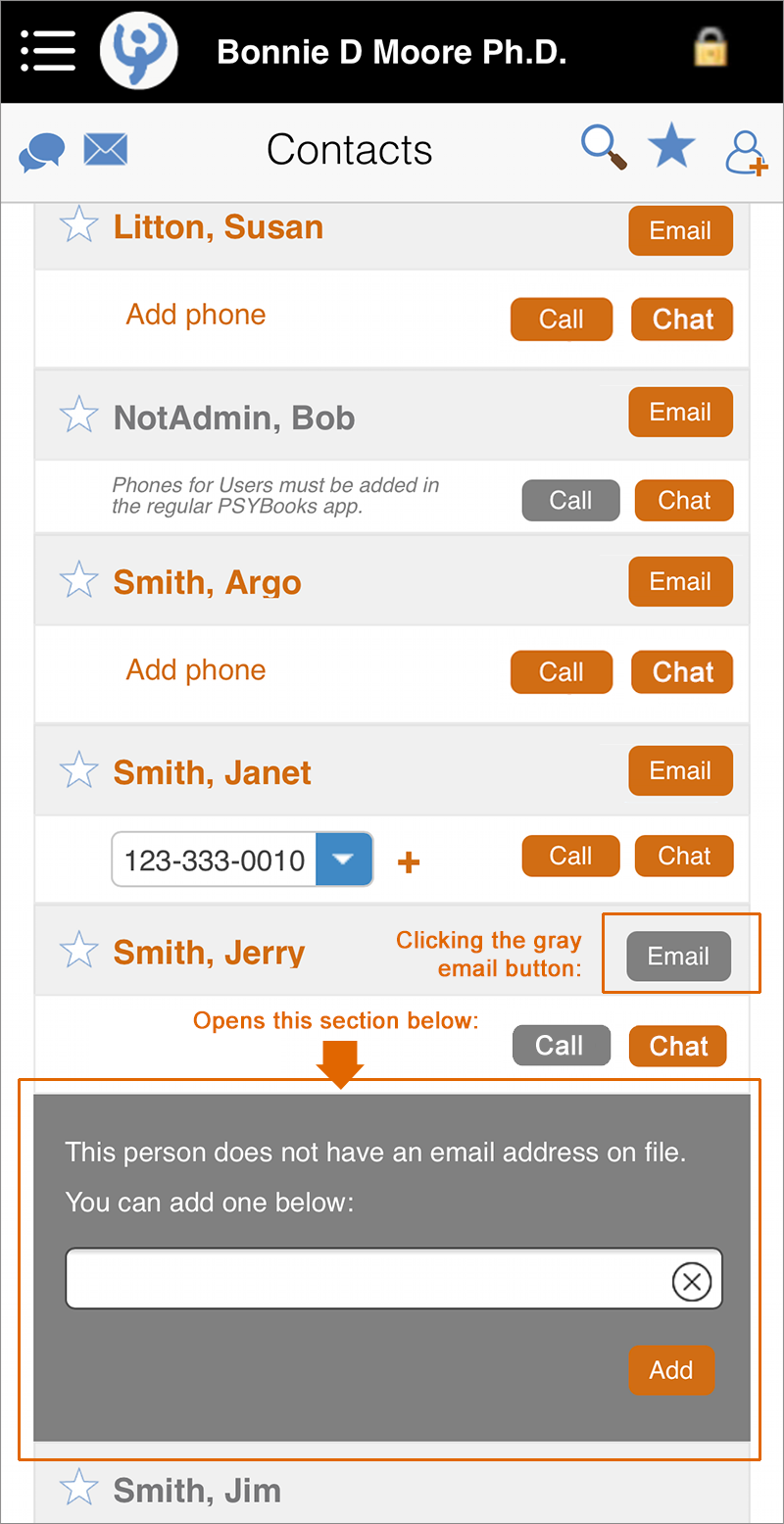
In the case above, since Jerry Smith's name is a link, we know that he's either a Client or a Person contact type. That means we can also click the link to edit his file and update the email address that way. Clicking the email button is a little easier but they both accomplish the same thing.
- Select Phone
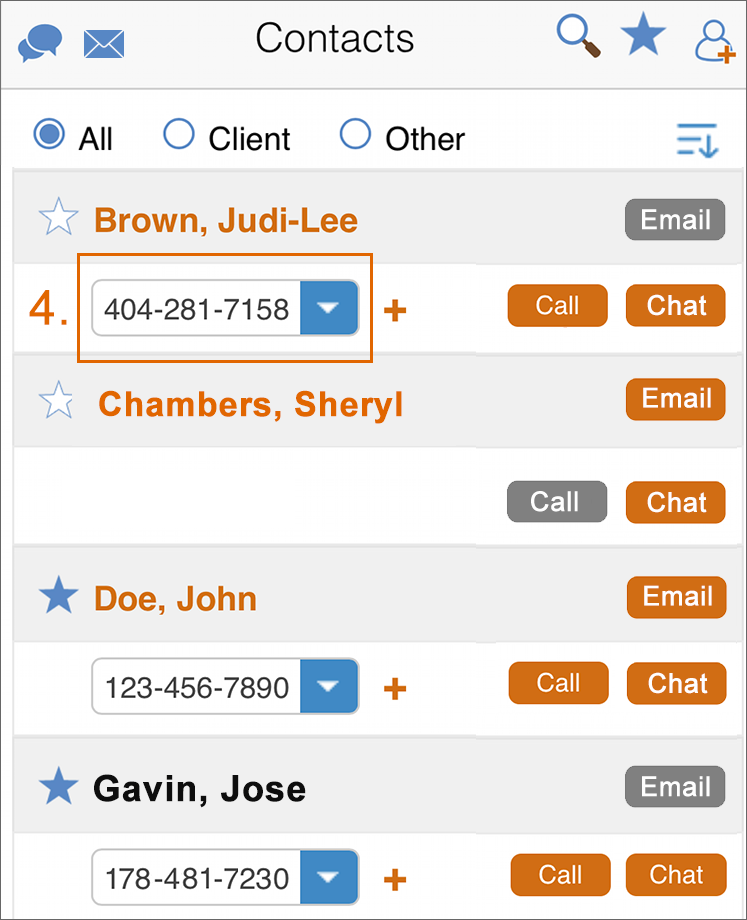
When the contact has at least one phone number listed in their chart, a phone select box will appear under their name. If they have more than one phone number, you can use the select box to choose the one you want. Once you have the correct phone number, press the orange "Call" button to place a call to that number.
Notice that Sheryl Chambers doesn't have a phone select box, and instead, has a gray "Call" button instead of an orange one. That's because there's currently no phone attached to her name. Clicking the gray "Call" button (or clicking her name, since it's a link) will allow you to add one. As we saw above, clicking the Call button is a little easier, since it will bring up the keyboard right away for you to enter the number. Clicking the link brings up a larger form with several fields. As always, since Mobile always syncs with the main PSYBooks app, adding it here will also add it to your complete PSYBooks app.
- Add New Phone
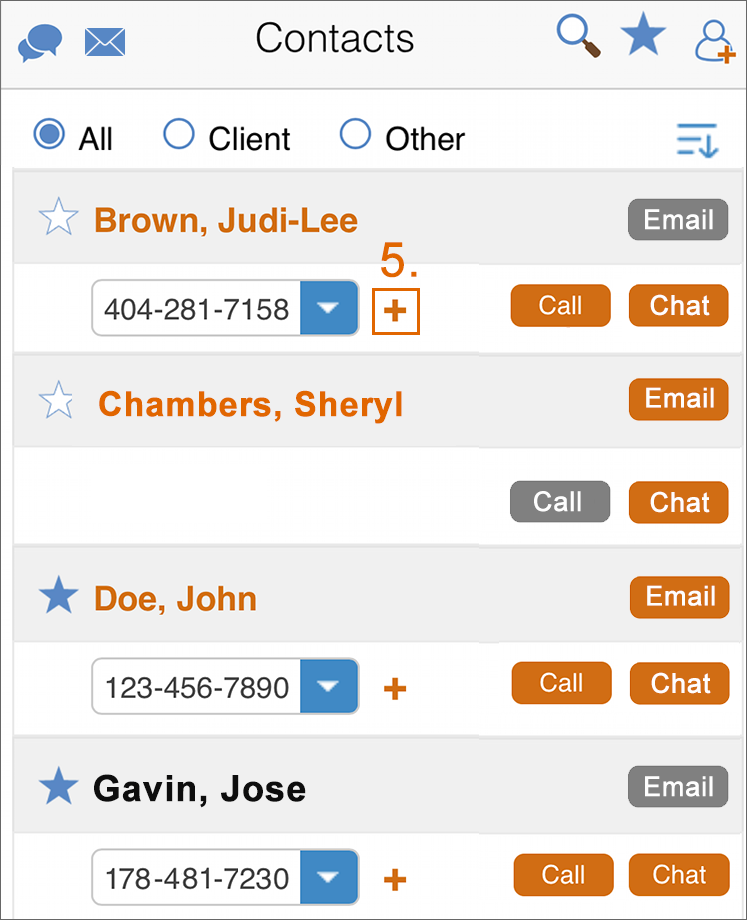
Assuming a contact has at least one phone number, a + will appear beside the select box. Pressing the plus sign will allow you to add another number for that individual.
Again, Sheryl Chambers does not have the Add Phone + because she doesn't yet have any phone numbers attached to her name. Once a single phone for her is added, the plus will appear to allow you to add additional phones.
- Place Call/Add Phone
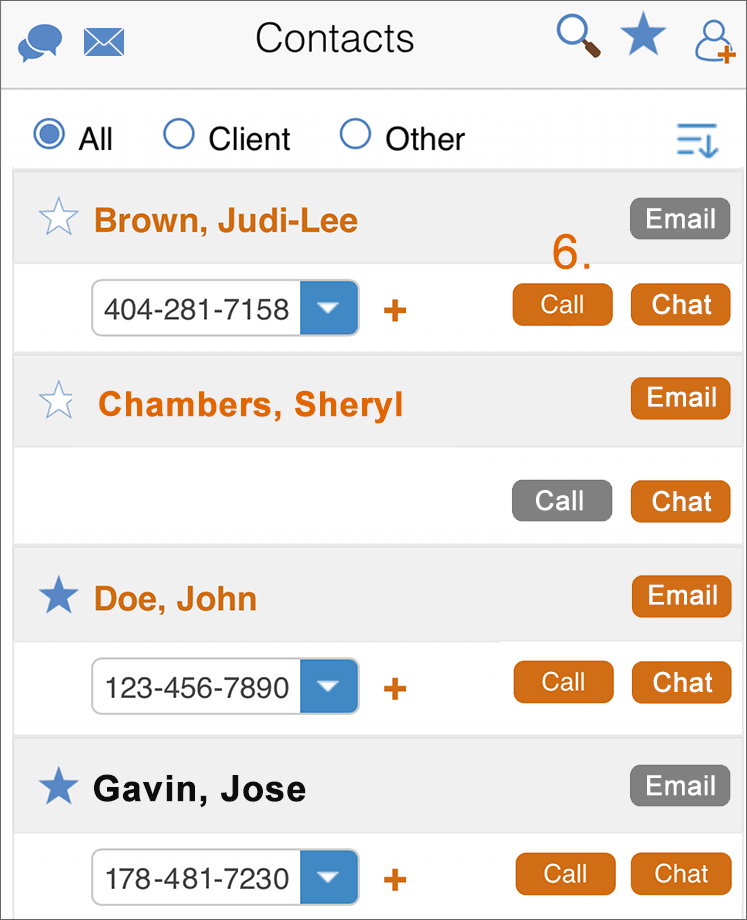
Once you've selected the phone number you wish to call, pressing the Call button will place the call - right from your mobile app. Individuals without phone numbers have gray Call buttons (such as Sheryl Chambers). However, you can click the gray button and add a phone for them if you have it.
- Start a Chat
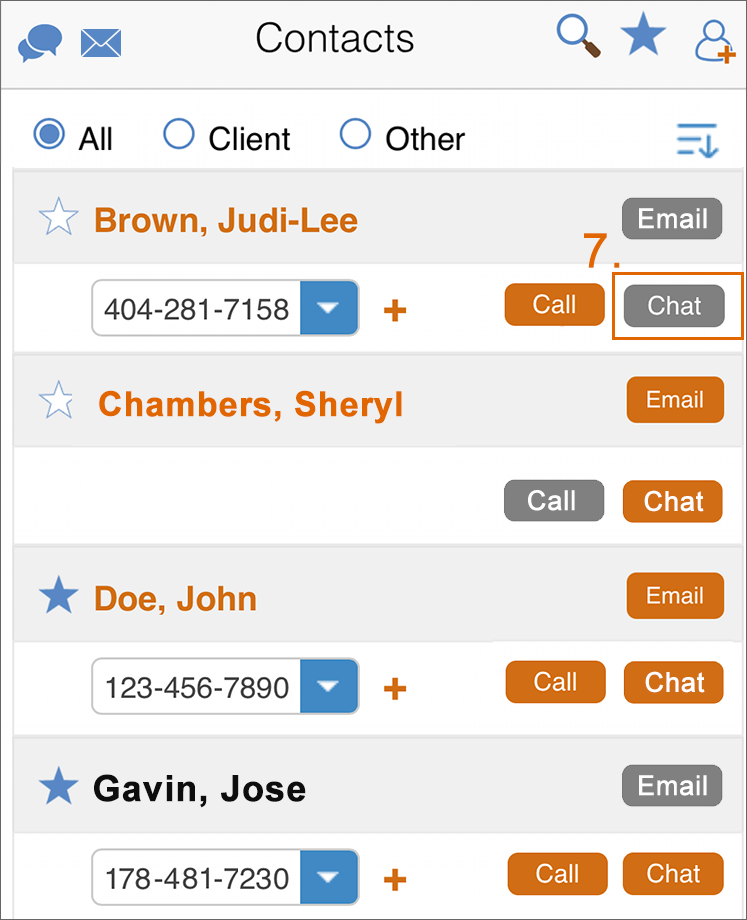
Like the Email and Call buttons, the Chat button can be gray or orange. Active Chat buttons are orange - indicating you can use them. Conversely, when a chat button is gray, it means that Chat is disabled for that individual. To understand the difference, it's important to realize that the entire PSYBooks Mobile app is encrypted and HIPAA-compliant. Part of what makes it that way is that to use it, you have to sign in. Although you COULD chat with any individual on your Contact list that had a phone, it would be no better than normal texting. It wouldn't comply with HIPAA.
For that reason, the chatting/texting feature in PSYBooks Mobile is only available to those who can sign in to the app. That includes Portal Users and also any Users or Subscribers on your PSYBooks account. In the mockup, we know that Jose Gavin must be either a User or a Subscriber since his name is not a link. (Neither Users nor Subscribers can be edited from Mobile.) However, since both Users and Subscribers have their own sign-in credentials to the PSYBooks app, the Chat/Text feature is always activated for them. They do not also have to be Portal Users on your account.
In contract, Judi-Lee Brown, Sheryl Chambers and John Doe DO have links for their names, meaning that they're Clients or Other > Persons. However, Judi-Lee has a gray chat button, indicating that it's NOT possible to chat with her. The subscriber CAN chat with Sheryl Chambers or John Doe, however, since thir Chat buttons are orange. The difference is that both Sheryl and John are Portal Users, whereas Judi-Lee is not. If you want to chat with Judi-Lee, you'd have to go to your regular PSYBooks app and send her a Portal User invite. Once she accepts, the two of you will be able to have encrypted chats in Mobile.
What Clients See
The mobile site for your clients - as well as any other Person contacts you've created - is not the same as yours. They have access to a calendar, but it only has their appointments on it - no one else's. They also have chat and email tools, but they can only chat or email with people with whom they're already connected. This will always be the subscriber, and may also be any Admin Users who have access to their charts in the regular app. Finally, if the client is a member of a group, all members of their group will be contacts with one another, which will enable group chats, group emails and group video appointments.
What Users See
In contrast, by definition, Users (typically Admins) have access to your site. Although they DO have their own email accounts, they do not have regular PSYBooks' accounts of their own. For this reason, when a User signs in to Mobile, they will be accessing your mobile site and will also have access to their own email account.


